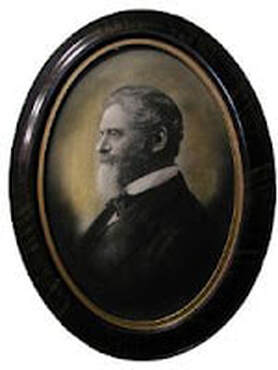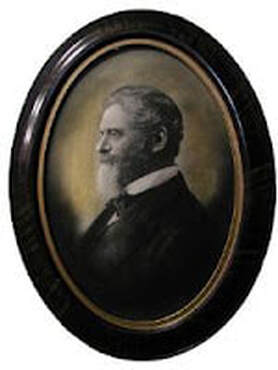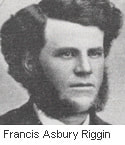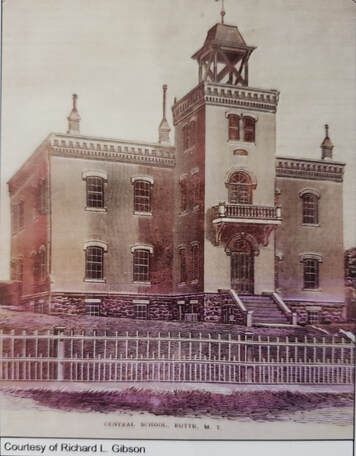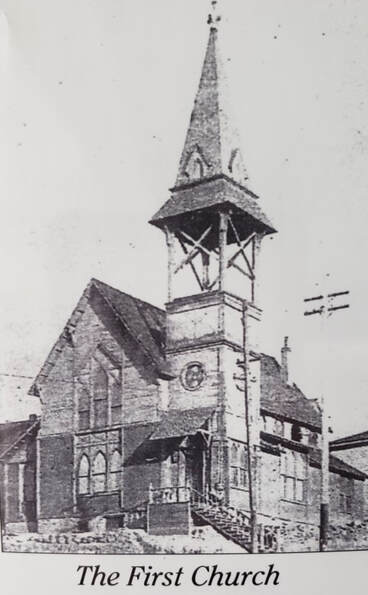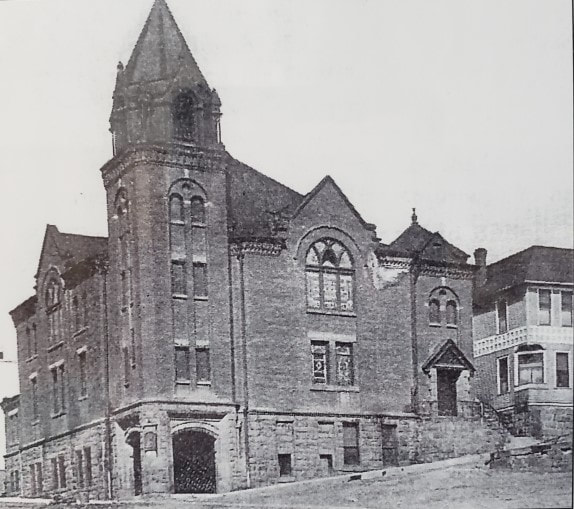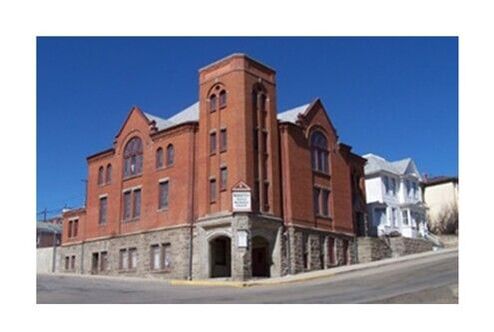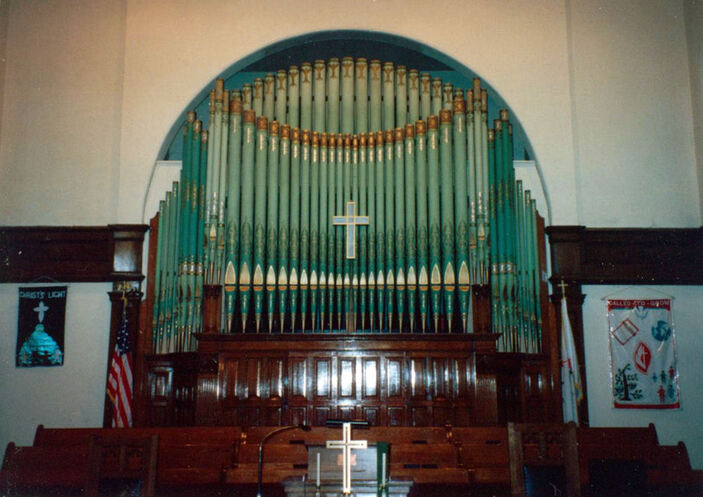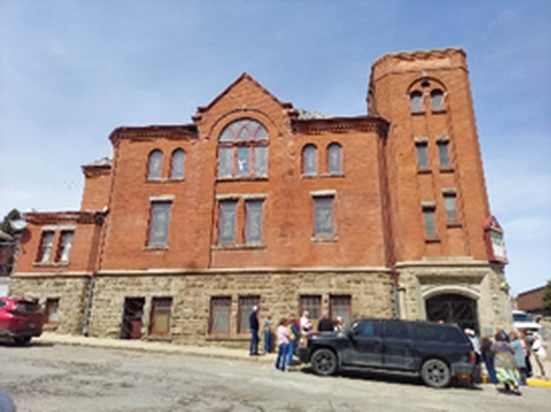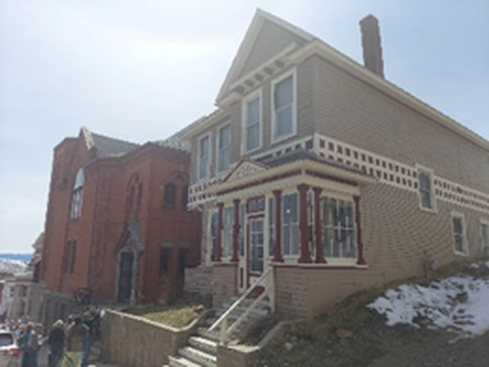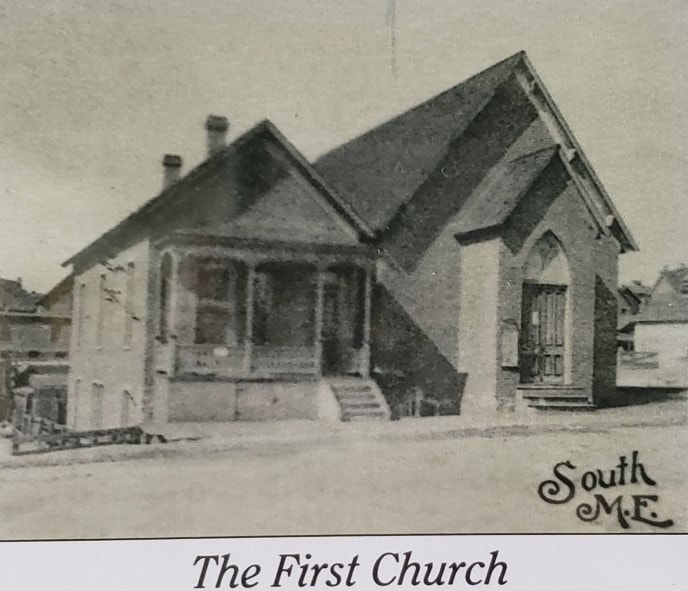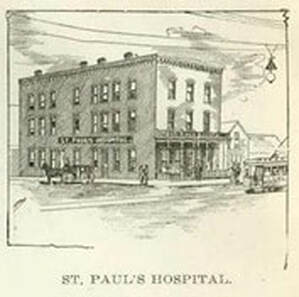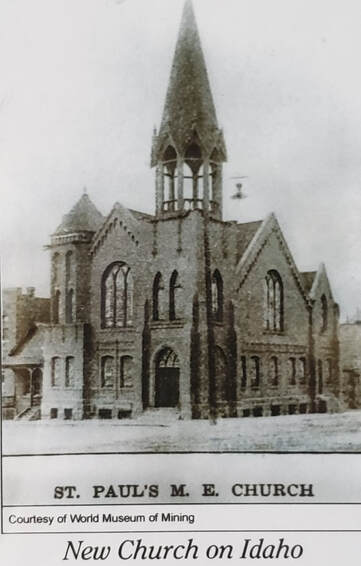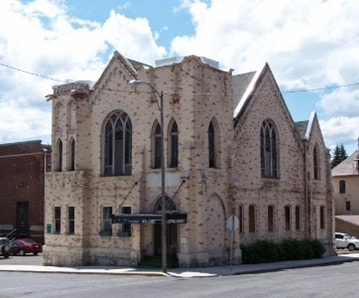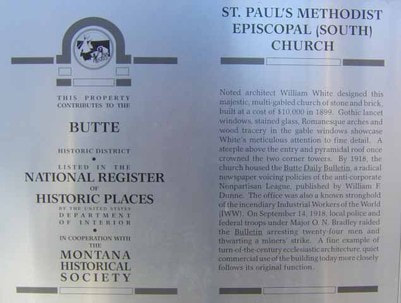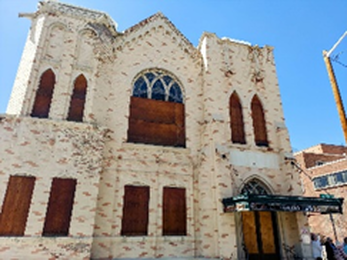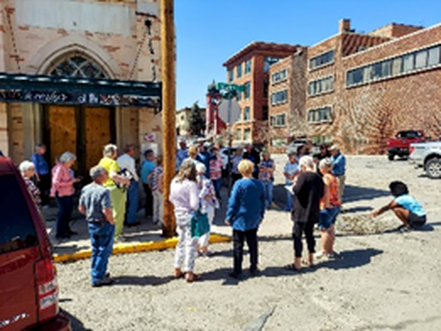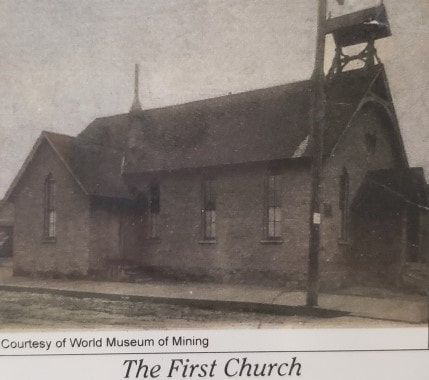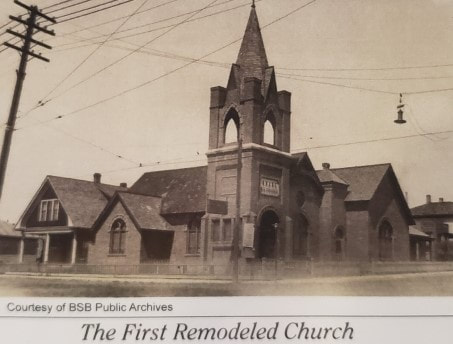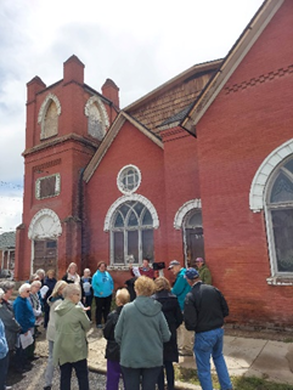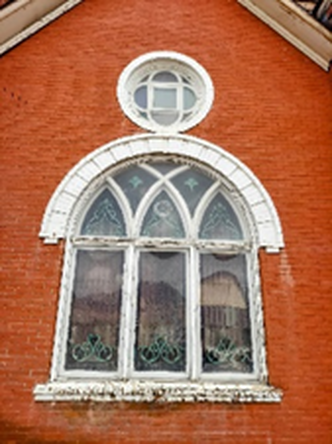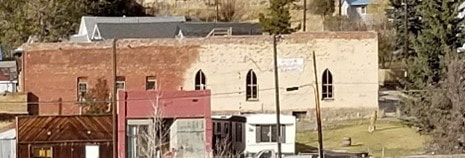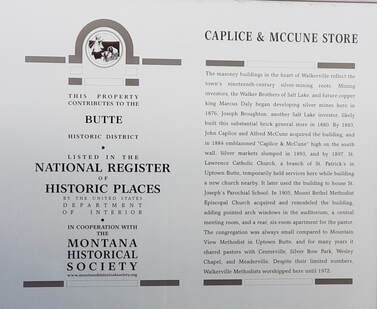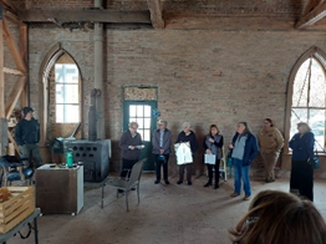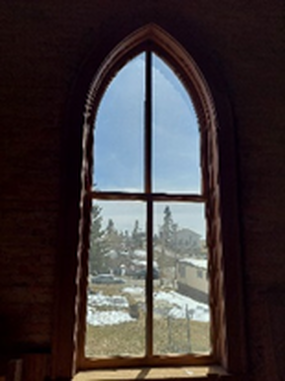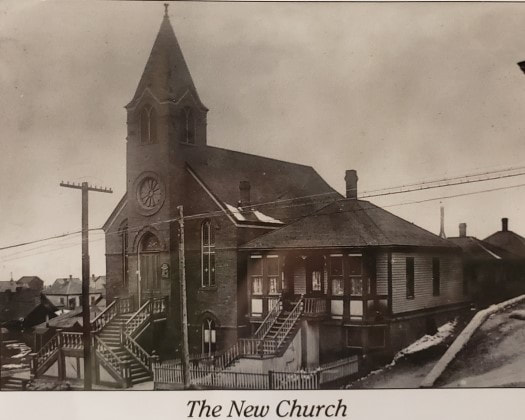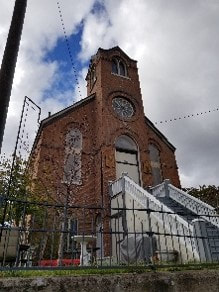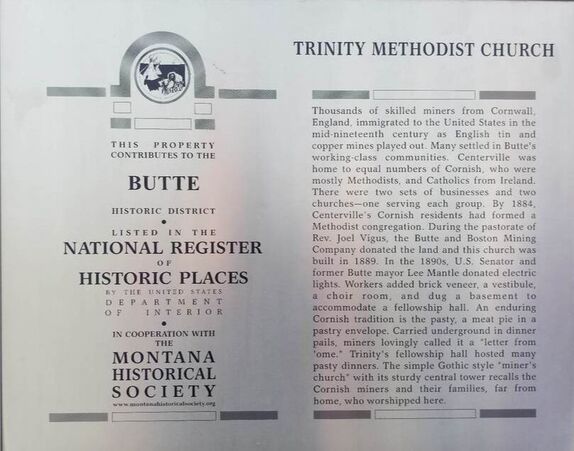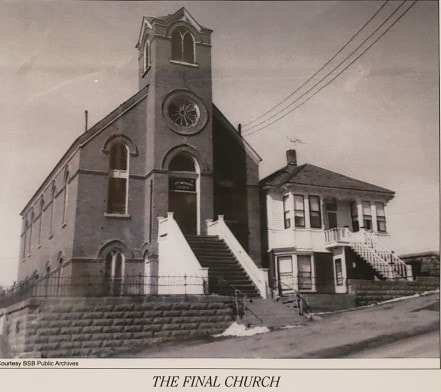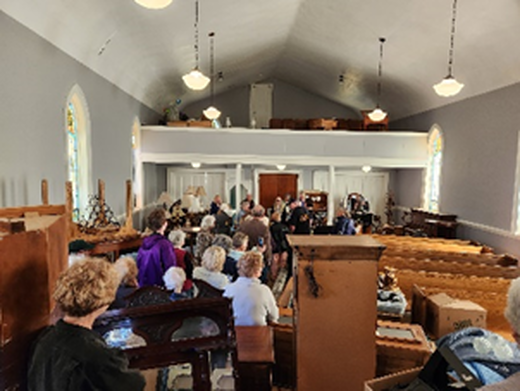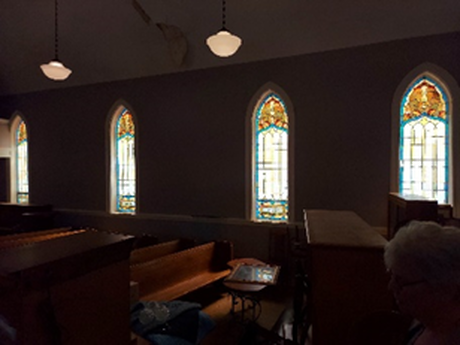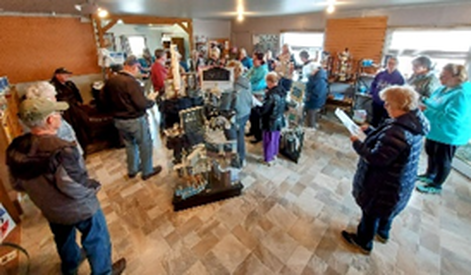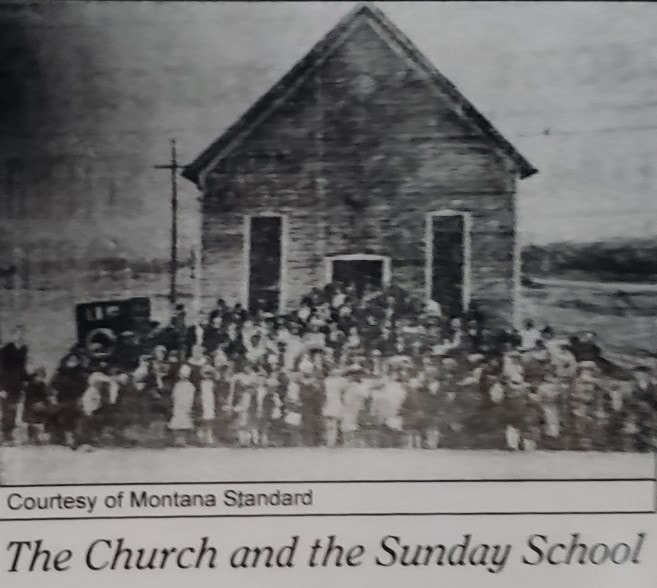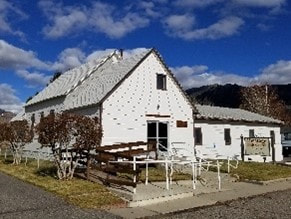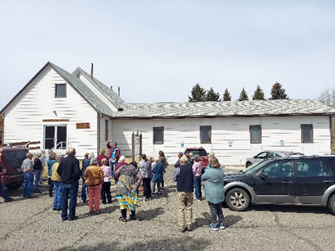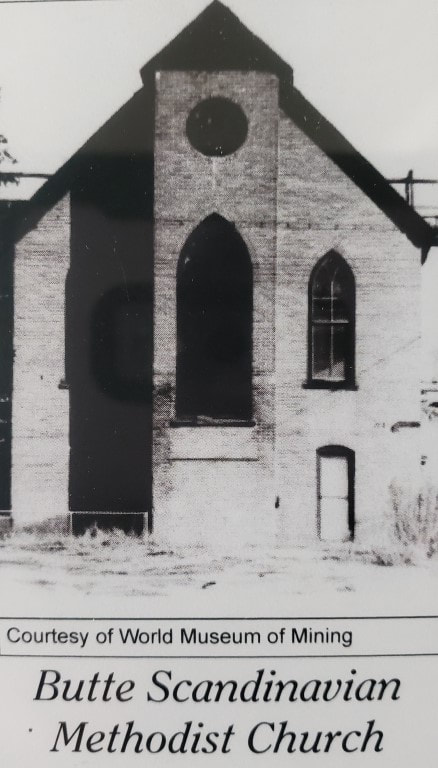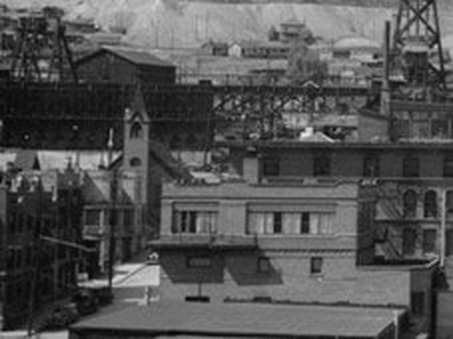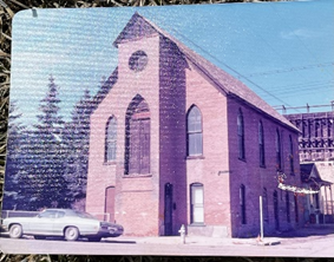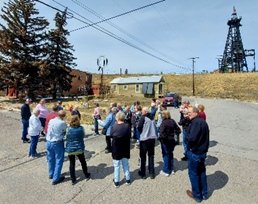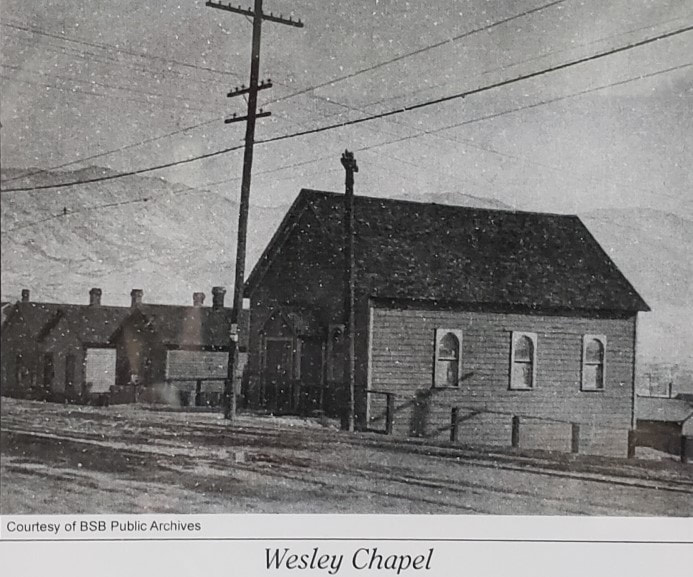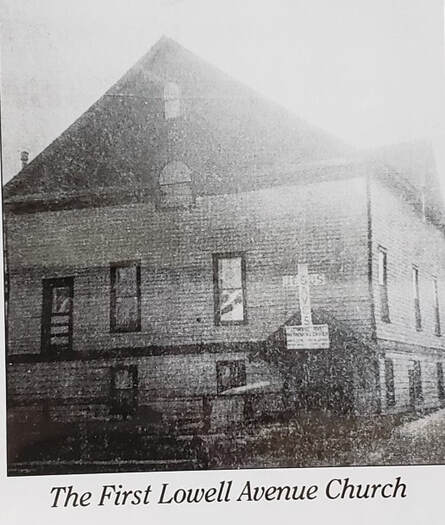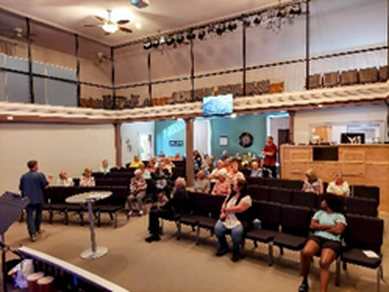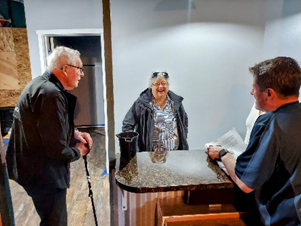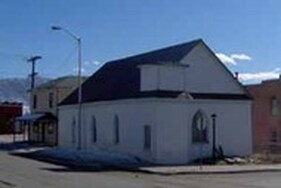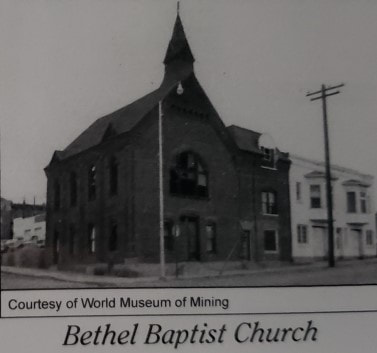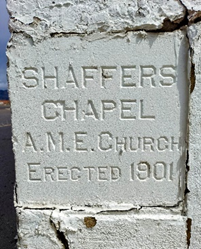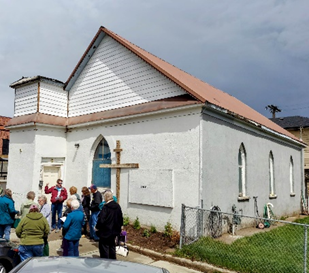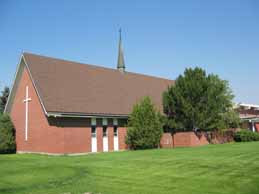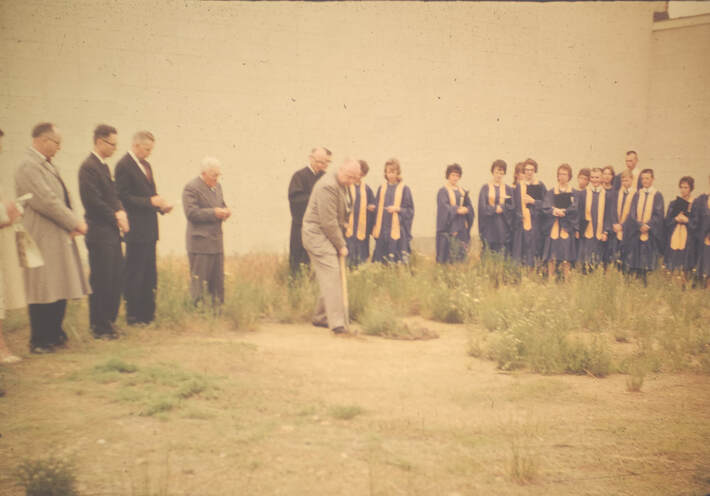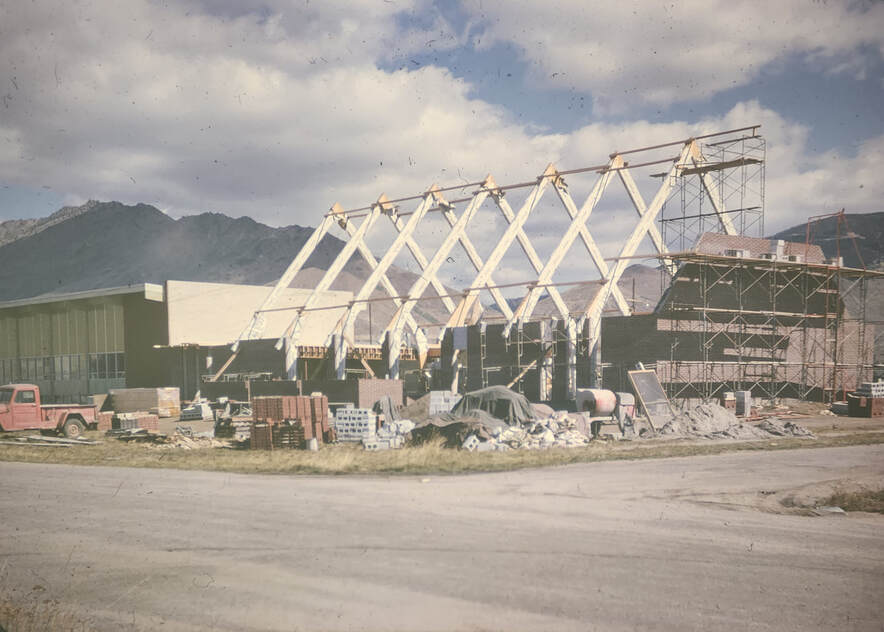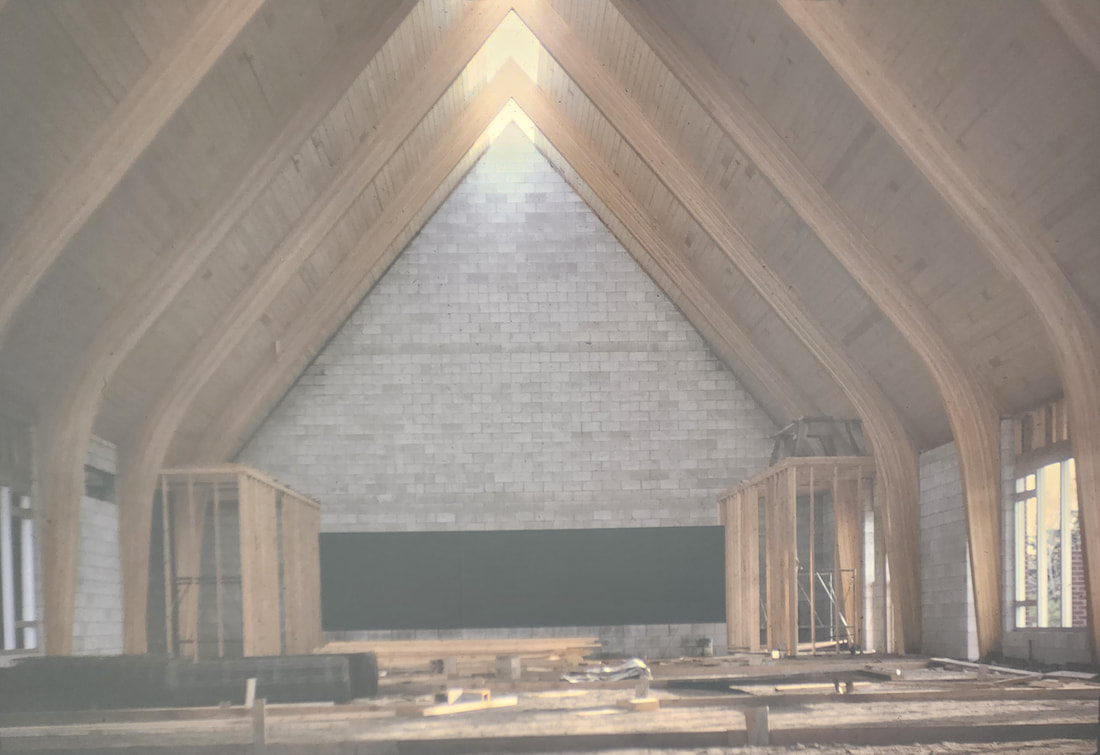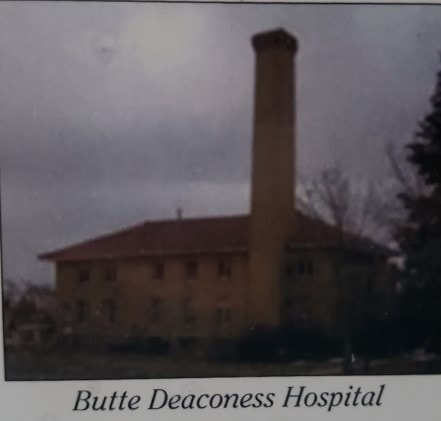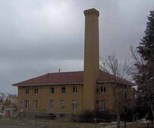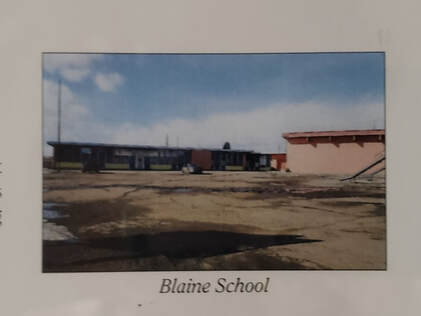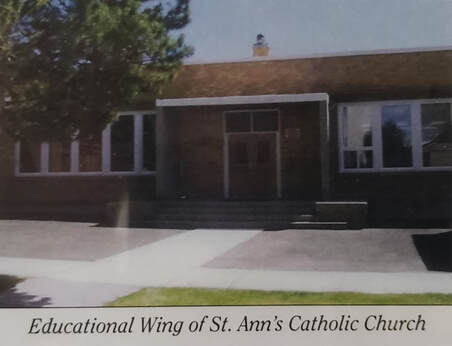Methodism on the Richest Hill on Earth
1873 - 2023
A brief history of the Methodist Church's service
and ministry in Butte, Montana
1873 - 2023
A brief history of the Methodist Church's service
and ministry in Butte, Montana
Link to: Butte Methodist’s roots (A)
Mountain View Church (1875-2015) (B)
Mountain View pastors (C)
Saint Paul Church (1878-1940s) (L)
Saint Paul pastors (M)
Grace Church (1879-1958) (D)
Grace pastors (E)
Mount Bethel Church (1883-1970) (F)
Mount Bethel pastors (G)
Trinity Church (1884–2015) (H)
Trinity pastors (I)
Unity Church (1887–1958) (J)
Unity pastors (K)
Saint George / Silver Bow Chapel (1890-1958) (N)
Saint George / Silver Bow pastors (O)
Scandinavian Church (1892-1908) (P)
Scandinavian pastors (Q)
Wesley Chapel (1897-1941) (R)
Wesley Chapel pastors (S)
Bellevue / Lowell Avenue Church (1907-1965) (T)
Bellevue / Lowell Avenue pastors (U)
Italian mission (1911- 1921) (V)
Italian mission pastors (W)
Shaffer Chapel African Methodist Episcopal Church (1892- 1964) (X)
Shaffer Chapel AME pastors (Y)
Aldersgate United Methodist Church (1959-present) (Z)
Aldersgate pastors (AA)
The Butte Deaconess Hospital (AB)
Mountain View Social Development Center (AC)
Mountain View Church (1875-2015) (B)
Mountain View pastors (C)
Saint Paul Church (1878-1940s) (L)
Saint Paul pastors (M)
Grace Church (1879-1958) (D)
Grace pastors (E)
Mount Bethel Church (1883-1970) (F)
Mount Bethel pastors (G)
Trinity Church (1884–2015) (H)
Trinity pastors (I)
Unity Church (1887–1958) (J)
Unity pastors (K)
Saint George / Silver Bow Chapel (1890-1958) (N)
Saint George / Silver Bow pastors (O)
Scandinavian Church (1892-1908) (P)
Scandinavian pastors (Q)
Wesley Chapel (1897-1941) (R)
Wesley Chapel pastors (S)
Bellevue / Lowell Avenue Church (1907-1965) (T)
Bellevue / Lowell Avenue pastors (U)
Italian mission (1911- 1921) (V)
Italian mission pastors (W)
Shaffer Chapel African Methodist Episcopal Church (1892- 1964) (X)
Shaffer Chapel AME pastors (Y)
Aldersgate United Methodist Church (1959-present) (Z)
Aldersgate pastors (AA)
The Butte Deaconess Hospital (AB)
Mountain View Social Development Center (AC)
The first prospectors arriving on the present site of Butte were recorded in 1864. There were just a few cabins scattered along Silver Bow Creek in which lived a few placer miners who had come over from Alder Gulch to look for gold. There was not much to be found in the bed of the creek, but views of ore were found, specifically copper.
The first formal "Methodist" religious services, of which we have a record, were held in Butte in early 1873 by Reverend Hugh Duncan, who was then serving as pastor of the Deer Lodge Mission. (A Marion J. Hall, who later served as the Methodist pastor and evangelist, is credited with the first “street meetings" in Butte.) Scotsman Duncan came to the United States in 1853. His son later wrote that "after a day of hard work he would study his lessons by the light of a candle, reading good literature and studying with a definite end in view, in the light of his accomplishments in later years." He was a licensed preacher for the Methodist Episcopal Church and helped start churches and Masonic Lodges wherever he went. Rev. Duncan is considered the first Methodist preacher in Montana to make this state his permanent home.
At the first gathering in 1872 of the Rocky Mountain Annual Conference of the Methodist Episcopal Church in Denver in 1872 Rev. Duncan was assigned to Deer Lodge and Missoula. Hugh was a miner, farmer, rancher, and preacher and came to the booming mining community of Butte to lead worship and lay the groundwork for a new church; this was in addition to his pastoral work in Salmon City, Idaho, some 160 miles away.
In 1875, Duncan, was appointed solely to work in Butte. The community was growing with mining interests all around.
In 1876 the name of Butte first appears in the official minutes of the Rocky Mountain Conference. W.C Shippen was sent from Helena to Butte. He stayed only a year, and the work was combined with Fish Creek in the Jefferson Valley. The following year, Francis Asbury Riggin, was made pastor of the circuit. This was the same year for the formation of the Montana Annual Conference. In 1887, the first meeting of the Montana Conference of the Methodist Episcopal Church took place at Mountain View Church.
In 1875, Duncan, was appointed solely to work in Butte. The community was growing with mining interests all around.
In 1876 the name of Butte first appears in the official minutes of the Rocky Mountain Conference. W.C Shippen was sent from Helena to Butte. He stayed only a year, and the work was combined with Fish Creek in the Jefferson Valley. The following year, Francis Asbury Riggin, was made pastor of the circuit. This was the same year for the formation of the Montana Annual Conference. In 1887, the first meeting of the Montana Conference of the Methodist Episcopal Church took place at Mountain View Church.
In the February 5th, 1890, edition of the Montana Advocate (the periodical of the Montana Methodists – which was published out of Butte), Francis Asbury Riggin writes: "My first appointment to preach in Butte carried me over the main Divide of the Rocky Mountains on horseback 30 miles, in the Fall of 1877. When I arrived, there was no church nor parsonage to receive me. Nor was there any organized work. I put my horse in the livery stable and went to the hotel and registered. I hunted up a place to preach and was informed that the only suitable place was a dance hall owned by Judge Loeber. He told me that his rate for the use of the hall on Sunday was $5. This would not put it in condition, and I must sweep it and light it and make the fires. This I was thankful to do. I had a good congregation. I paid the $5 out of my own pocket, I paid my bill at the livery stable for my horse, I paid my hotel bill; it all amounted to $10. I received no compensation."
"I couldn’t stay long but I went to the townsite Co. plat and selected six lots for a church. These were the nearest vacant lots to Main Street. I agreed to pay for them when the deed was furnished. On my return I found that they were sold to another and conveyed. After preaching a few times with a similar experience as narrated above I found a stopping place at the home of Brother A.T. Rundel and sons, and others, and the hotel bill was wiped out, but the livery bill and the hall bill went on. I made another attempt to purchase two lots, this time in the block where the Presbyterian Church now stands, having agreed on the price before the conveyance. Another offered better inducements and got the lots."
"In the meantime, our congregation steadily increased, filling frequently the spacious hall which would seat more people than any church edifice now in Butte. When the new schoolhouse was built, we moved to that building, upstairs; we got its use by paying the same rent. As it paid Paul even if it robbed Peter, we felt glad to aid the school fund".
"I couldn’t stay long but I went to the townsite Co. plat and selected six lots for a church. These were the nearest vacant lots to Main Street. I agreed to pay for them when the deed was furnished. On my return I found that they were sold to another and conveyed. After preaching a few times with a similar experience as narrated above I found a stopping place at the home of Brother A.T. Rundel and sons, and others, and the hotel bill was wiped out, but the livery bill and the hall bill went on. I made another attempt to purchase two lots, this time in the block where the Presbyterian Church now stands, having agreed on the price before the conveyance. Another offered better inducements and got the lots."
"In the meantime, our congregation steadily increased, filling frequently the spacious hall which would seat more people than any church edifice now in Butte. When the new schoolhouse was built, we moved to that building, upstairs; we got its use by paying the same rent. As it paid Paul even if it robbed Peter, we felt glad to aid the school fund".
Mountain View Church
The Rev. Francis Asbury Riggin was holding services in a two-story school building later occupied by the Public Library. The upper floor was used for all kinds of public purposes and on Sunday afternoon there was held a Union Sunday School. This is the birth of Mountain View Methodist Episcopal Church and the first Protestant congregation in the community.
F.A Riggin writes: "Our labors culminated in a gracious revival in the spring of 1878 in which I was aided by my colleague and brother, W.W. Van Orsdel. There were about 50 conversions. At this time, we organized a church and a Board of Trustees. I obtained the promise of two lots where the church now stands, borrowed the money out of the bank of Clark & Larrabie on my own responsibility and paid for them. Their cost was $150. We took up a subscription for a church … The first church was built on these lots and later a parsonage."
Between 1880 and 1883 the first church building was completed, and a parsonage built. Riggin writes: "The trustees selected from our plans the present building. When the bids were examined the contractor, whose bid was accepted backed out. We began the building by working in the subscribers who promised work. The first day revealed the fact that it would take too long that way. We finally got the cellar excavated, the foundation laid, and the superstructure begun. We asked for bids for its completion and after one was accepted, the contract made and the bidders had signed, the trustees who were not church members, feeling that they would become personally responsible, declined to sign it. I wouldn’t insist on the other members doing so but pocketed the contract and met its conditions during the progress of the enterprise until our term of three years expired." (He refers to the term of his pastorate, 3 years being the limit then.) "Then the building was so far completed that we held our conference of 1880 in it … The enterprise cost me twice as much as I received during my pastorate from the charge for the three years while I was there, and while it was not the comfortable charge that it is now, I have had some consolation in the promise of the Savior as contained in Mark 10:30, some of which I have already obtained."’
F.A Riggin writes: "Our labors culminated in a gracious revival in the spring of 1878 in which I was aided by my colleague and brother, W.W. Van Orsdel. There were about 50 conversions. At this time, we organized a church and a Board of Trustees. I obtained the promise of two lots where the church now stands, borrowed the money out of the bank of Clark & Larrabie on my own responsibility and paid for them. Their cost was $150. We took up a subscription for a church … The first church was built on these lots and later a parsonage."
Between 1880 and 1883 the first church building was completed, and a parsonage built. Riggin writes: "The trustees selected from our plans the present building. When the bids were examined the contractor, whose bid was accepted backed out. We began the building by working in the subscribers who promised work. The first day revealed the fact that it would take too long that way. We finally got the cellar excavated, the foundation laid, and the superstructure begun. We asked for bids for its completion and after one was accepted, the contract made and the bidders had signed, the trustees who were not church members, feeling that they would become personally responsible, declined to sign it. I wouldn’t insist on the other members doing so but pocketed the contract and met its conditions during the progress of the enterprise until our term of three years expired." (He refers to the term of his pastorate, 3 years being the limit then.) "Then the building was so far completed that we held our conference of 1880 in it … The enterprise cost me twice as much as I received during my pastorate from the charge for the three years while I was there, and while it was not the comfortable charge that it is now, I have had some consolation in the promise of the Savior as contained in Mark 10:30, some of which I have already obtained."’
One of the ‘prominent Montana men’ to help build the Mountain View Church was Patrick Carney. He later became nationally famous for raising potatoes in the Jefferson Valley where he supplied "great big baked potatoes" on the dining cars of the Northern Pacific railway. He relates how the trustees of Mountain View faced a problem: "… the lots where the church now stands could be gotten for nothing and two blocks down the hill there were two other lots for sale for $300. They chose the free lots. The Baptists later bought the other lots; but as a result, ‘successive generations of Methodists have had to toil two blocks further up the hill.’" This conflicts with Riggin’s version of his paying the $150 cost … Riggin probably kept his part confidential at the time and both versions make a great story!
Early-day Presbyterian minister, J.R. Russell also relates that the four congregations that had shared the Union School (Episcopalians, Presbyterians, Methodist Episcopalians, and Southern Methodists) all used the new Mountain View facilities for a time. He relates that "it was only partially completed, and muslin took the place of glass for windows."
Early-day Presbyterian minister, J.R. Russell also relates that the four congregations that had shared the Union School (Episcopalians, Presbyterians, Methodist Episcopalians, and Southern Methodists) all used the new Mountain View facilities for a time. He relates that "it was only partially completed, and muslin took the place of glass for windows."
The building was totally paid for by 1885, over the protests of the “official members.” These were some of the most prominent and wealthy people in Montana, who protested the fact that missionary aid money paid off the remaining debt.
In 1887 the first annual session of the Montana Annual Conference was held at the Mountain View Methodist Episcopal Church. For many years, this congregation was the largest in the Conference. Out of this congregation, Dr. Phoebe A. Ferris, went to India and later China as a medical missionary and the women’s fellowship continued supporting her missionary work until her retirement. She returned to Butte in the 1920’s to run the Deaconess Hospital (link to ()) In 1899, Governor Rickards reported that "Methodism was never so prosperous nor more promising than now."
In 1887 the first annual session of the Montana Annual Conference was held at the Mountain View Methodist Episcopal Church. For many years, this congregation was the largest in the Conference. Out of this congregation, Dr. Phoebe A. Ferris, went to India and later China as a medical missionary and the women’s fellowship continued supporting her missionary work until her retirement. She returned to Butte in the 1920’s to run the Deaconess Hospital (link to ()) In 1899, Governor Rickards reported that "Methodism was never so prosperous nor more promising than now."
The present structure, located at 301 North Montana, was begun in 1898. During its construction, services were held in the courthouse and gatherings of over 1000 worshipers were not uncommon. On February 25, 1900, just 2 days less under year after it was decided to build, the first worship service was held in the new, beautiful, conveniently arranged and elegantly furnished church. The total cost of the church, complete with organ, stained glass windows, carpeting, seats, and so forth, was $25,000.
The cornerstone laying was quite an event, with Senator Clark, Ex-governor Rickards, and the ‘most beloved person in Montana’ Brother Van (Rev. Wm. Wesley Van Orsdel) all giving speeches from a platform adorned with freshly cut pine trees and an American Flag flying twenty feet above the crowd.
The cornerstone laying was quite an event, with Senator Clark, Ex-governor Rickards, and the ‘most beloved person in Montana’ Brother Van (Rev. Wm. Wesley Van Orsdel) all giving speeches from a platform adorned with freshly cut pine trees and an American Flag flying twenty feet above the crowd.
The grand gothic style was probably designed by Butte architects Link and Donovan and the complex geometrical and floral designs of the stained-glass windows suggests that they were built by the then flourishing Butte Art Glass Works. Copper King and later U.S. Senator, W.A. Clark was then the president of the church’s Board of Trustees and Butte's first mayor, Henry Jacobs, was also a Trustee. In the early 1940's the windows flanking the organ were given as memorials and constructed by the J.&R. Lamb Studios of New York. A spectacular organ was installed in 1949, by Kilgen Co. at a cost of $12,000.
In 1964, the church purchased property at the corner of Montana and Centennial. Unfortunately, due to unmanageable financial circumstances, the plans for the new building and the property were shelved, and the land was sold.
In 1966, the four existing Methodist Churches in Butte laid plans for a larger parish. Three pastors were assigned to the parish: Marion Hixon, Robert Link, and John Pugh. The parsonage, located just north of the church, was sold to help purchase three new parsonages. The parish dissolved in 1980 with Bob Craver retaining his appointment with Mountain View and Trinity (also known as the “hill” churches). Bob’s grandparents had been members of the church and Bob joined the congregation in 1944.
In 1999, the church celebrated 100 years in its current building. Unfortunately, the size of the building and the upkeep of a structure that lasted over 100 years made it difficult for the congregation to continue. The Foundation fund that was established in 1937 was beginning to run out. The congregation voted to close and a final ceremony was held on July 5, 2015. The remaining members were hosted by a celebration at Aldersgate Church. The closing orders of the congregation were read by the Montana West District Superintendent, Kama Hamilton Morton, who lived in Butte when her father served the Aldersgate congregation.
In 1964, the church purchased property at the corner of Montana and Centennial. Unfortunately, due to unmanageable financial circumstances, the plans for the new building and the property were shelved, and the land was sold.
In 1966, the four existing Methodist Churches in Butte laid plans for a larger parish. Three pastors were assigned to the parish: Marion Hixon, Robert Link, and John Pugh. The parsonage, located just north of the church, was sold to help purchase three new parsonages. The parish dissolved in 1980 with Bob Craver retaining his appointment with Mountain View and Trinity (also known as the “hill” churches). Bob’s grandparents had been members of the church and Bob joined the congregation in 1944.
In 1999, the church celebrated 100 years in its current building. Unfortunately, the size of the building and the upkeep of a structure that lasted over 100 years made it difficult for the congregation to continue. The Foundation fund that was established in 1937 was beginning to run out. The congregation voted to close and a final ceremony was held on July 5, 2015. The remaining members were hosted by a celebration at Aldersgate Church. The closing orders of the congregation were read by the Montana West District Superintendent, Kama Hamilton Morton, who lived in Butte when her father served the Aldersgate congregation.
On April 23rd, as part of 150 years of Methodism in Butte celebration, the public was invited to the location of this historic site. Although, we did not gain access to the interior, we heard stories from Sue DeBree, a former pastor, along with other members of this vital congregation. We learned of the massive granite stones that line the church and the former parsonage; both locations are listed on the National Historic Registry. Dave Goodwin, current owner of the facility, has promised us access to the interior at a later date.
Pastors who served the Mountain View congregation …
Hugh Duncan (1875-1876)
W.C. Shippen (1876-1877)
Francis Asbury Riggen (1877-1880)
J.J. Garvin (1880-1883)
Samuel Winger (1883)
George C. Stull (1883-1884)
J.B. Chynoweth (1884-1885)
William A. Shannon (1885)
William E. King (1885-1888)
John J. McAllister (1888-1890)
Frank E. Brush (1890-1892)
Gardner D. Holmes (1892-1893)
William Rollins (1893-1897)
E.B. Lounsbury (1897-1898)
Josiah L. Albritton (1898-1901)
Alfred H. Henry (1901-1903)
Corliss Hargraves, associate pastor (1901-1902)
Charles L. Bovard (1903-1906)
Arthur P. Morrison (1906-1909)
A.D. Batchelor (1909-1910)
George D. Wolfe (1910-1920)
Thomas R. Clarkson, associate pastor (1917-1919)
Charles Wolfe, associate pastor (1918)
J. C. Randall (1920-1921)
Cecil L. Clifford (1921-1926)
Charles G. Cole (1926-1932)
Gertrude Schaal, associate pastor (1928)
Andrew C. Caton (1932-1944)
J. Homer Magee (1944-1946)
Richard Lungren (1948-1952)
Alexander R. Henry (1952-1954)
Clarence G. Spellman (1954-1956)
Richard F. Vick (1956-1962)
Charles A. Nowlen Jr. (1962-1966)
Butte Methodist Larger Parish (1966-1980)
Marion Hixson (1966-1968), Minister of Preaching
Robert Link (1966-1970), Minister of Education
John E. Pugh (1968-1972)
Gayle Sandholm (1970-1972)
Donald Keefauver (1971-1972)
Roger Robinson (1972-1974)
Daniel W. Wanders (1972-1976)
Robert C. Baker (1975-1977)
John W. Bartram (1976-1979)
Robert A. Craver (1979-1980)
Robert A. Craver (1981-1992)
Susan K. DeBree (1993-2002)
Richard Rice (2002-2005)
Ben Nardi (2005-2006)
Mike Parr (2006-2007)
Gary Treglown (2007-2009)
Dee Anna (2009-2012)
Ron Martin Dent (2012-2015)
Hugh Duncan (1875-1876)
W.C. Shippen (1876-1877)
Francis Asbury Riggen (1877-1880)
J.J. Garvin (1880-1883)
Samuel Winger (1883)
George C. Stull (1883-1884)
J.B. Chynoweth (1884-1885)
William A. Shannon (1885)
William E. King (1885-1888)
John J. McAllister (1888-1890)
Frank E. Brush (1890-1892)
Gardner D. Holmes (1892-1893)
William Rollins (1893-1897)
E.B. Lounsbury (1897-1898)
Josiah L. Albritton (1898-1901)
Alfred H. Henry (1901-1903)
Corliss Hargraves, associate pastor (1901-1902)
Charles L. Bovard (1903-1906)
Arthur P. Morrison (1906-1909)
A.D. Batchelor (1909-1910)
George D. Wolfe (1910-1920)
Thomas R. Clarkson, associate pastor (1917-1919)
Charles Wolfe, associate pastor (1918)
J. C. Randall (1920-1921)
Cecil L. Clifford (1921-1926)
Charles G. Cole (1926-1932)
Gertrude Schaal, associate pastor (1928)
Andrew C. Caton (1932-1944)
J. Homer Magee (1944-1946)
Richard Lungren (1948-1952)
Alexander R. Henry (1952-1954)
Clarence G. Spellman (1954-1956)
Richard F. Vick (1956-1962)
Charles A. Nowlen Jr. (1962-1966)
Butte Methodist Larger Parish (1966-1980)
Marion Hixson (1966-1968), Minister of Preaching
Robert Link (1966-1970), Minister of Education
John E. Pugh (1968-1972)
Gayle Sandholm (1970-1972)
Donald Keefauver (1971-1972)
Roger Robinson (1972-1974)
Daniel W. Wanders (1972-1976)
Robert C. Baker (1975-1977)
John W. Bartram (1976-1979)
Robert A. Craver (1979-1980)
Robert A. Craver (1981-1992)
Susan K. DeBree (1993-2002)
Richard Rice (2002-2005)
Ben Nardi (2005-2006)
Mike Parr (2006-2007)
Gary Treglown (2007-2009)
Dee Anna (2009-2012)
Ron Martin Dent (2012-2015)
Saint Paul Church
In 1840, the Methodist Episcopal Church, like many denominations in the United States split over the issue of slavery. It would be almost 100 years (1939) before the denomination would come back together, long after the results of the Civil War. The Methodist Episcopal Church, South worked almost exclusively in the southern United States, but in certain parts of the north, the Methodist Episcopal Church, South was active. One of these locations was Montana.
The Reverend L. B. Stateler brought Southern Methodism to Montana when he arrived at Virginia City in 1864. First services in the Bitterroot valley were held in 1870 and G. O. Hilton was appointed first pastor at Corvallis in 1871. The work of the denomination flourished in Montana, which was far from the original home of the church in the Deep South, due to pioneer preachers like Stateler. They worked tirelessly amongst mining communities finding families who sought worship in their own communion (or denomination) but pastors and churches from their own denominations were few and far between.
The Reverend L. B. Stateler brought Southern Methodism to Montana when he arrived at Virginia City in 1864. First services in the Bitterroot valley were held in 1870 and G. O. Hilton was appointed first pastor at Corvallis in 1871. The work of the denomination flourished in Montana, which was far from the original home of the church in the Deep South, due to pioneer preachers like Stateler. They worked tirelessly amongst mining communities finding families who sought worship in their own communion (or denomination) but pastors and churches from their own denominations were few and far between.
In 1871, the Western Conference of the Methodist Episcopal Church, South mentions the appointment of F. E. Taylor to the Silver Bow station of the Deer Lodge District. There is no evidence, however, that Rev. Taylor ever made it to the area.
In 1878, Edwin J. Stanley is listed under appointment of the new Butte Circuit. 1878 is the first year of the newly created Montana Conference of the Methodist Episcopal Church, South. In 1879, Bishop J. C. Keener preached in Butte just before holding Annual Conference in Willow Creek. In a 13 year period, Butte hosted Annual Conference; showing the growth of the congregation. In 1885, we find the first mention of a congregation in Anaconda.
In 1899, a new building was erected on the site of the existing church structure (google maps). Noted architect William White designed this majestic, multi-gabled church of stone and brick, built at a cost of $16,000. Gothic lancet windows, stained glass, Romanesque arches, and wood tracery in the gable windows showcase White’s meticulous attention to fine detail. A steeple above the entry and pyramidal roof once crowned the two corner towers, visible in the 1905 sketch.
In 1878, Edwin J. Stanley is listed under appointment of the new Butte Circuit. 1878 is the first year of the newly created Montana Conference of the Methodist Episcopal Church, South. In 1879, Bishop J. C. Keener preached in Butte just before holding Annual Conference in Willow Creek. In a 13 year period, Butte hosted Annual Conference; showing the growth of the congregation. In 1885, we find the first mention of a congregation in Anaconda.
In 1899, a new building was erected on the site of the existing church structure (google maps). Noted architect William White designed this majestic, multi-gabled church of stone and brick, built at a cost of $16,000. Gothic lancet windows, stained glass, Romanesque arches, and wood tracery in the gable windows showcase White’s meticulous attention to fine detail. A steeple above the entry and pyramidal roof once crowned the two corner towers, visible in the 1905 sketch.
Rev. Settle arrived from Missouri to serve the Saint Paul’s congregation in 1899. He was instrumental in the construction of the building located at the corner of Galena and Idaho. After his first year of ministry, Joseph Settle saw the need for a hospital. A commodious building was secured, and, on June 29, 1899, the work of remodeling it was institute, and in due time it was admirably arranged and equipped as a hospital. The institution was called Saint Paul’s hospital. The short-lived hospital stood at the southeast corner of Gold and Montana Streets, 502 S. Montana. It was only listed in the city directories from 1900-1902, even though Western Resources Magazine in 1901 reported that “the sum of $500 has recently been spent in the operating room alone … For a dollar a month … one can have medical treatment, board, nursing and surgical attendance, and furthermore the choice of thirty doctors.”
Rev. Settle was the President and General Manager of the hospital, also known as Johnston House. The hospital, however, was “entirely non-sectarian, Jew or Gentile, Christian or unbeliever, all receiving the same skilled, considerate, conscientious care.” Sisters Hospital, which became St. James, was already in operation and was much larger, so it may have forced St. Paul’s hospital out of business.
Rev. Settle was the President and General Manager of the hospital, also known as Johnston House. The hospital, however, was “entirely non-sectarian, Jew or Gentile, Christian or unbeliever, all receiving the same skilled, considerate, conscientious care.” Sisters Hospital, which became St. James, was already in operation and was much larger, so it may have forced St. Paul’s hospital out of business.
The congregation moved to a small building on Wharton Street (location unknown). Pastors are listed as serving the St. Paul congregation around the time of 1940. The congregation ceases to be in the records until 1954 when the other Methodist Episcopal Church, South congregation (Lowell Avenue) changes its name to Saint Paul.
By 1918, the church was owned by mortician (and later Silver Bow Sheriff) Larry Dugan, a sympathizer with the incendiary Industrial Workers of the World (IWW). The building then housed the Butte Daily Bulletin (later known as the Butte Strike Bulletin), a radical newspaper voicing policies of the anti-Anaconda Nonpartisan League, published by William F. Dunne. On September 13, 1918, local police and federal troops under Major Omar N. Bradley raided the Bulletin, arresting twenty-four men and thwarting a miners’ strike.
It is now on the National Historic Registry. The boards over the current location were placed to preserve the windows.
On April 30th, as part of 150 years of Methodism in Butte celebration, the public was invited to the location of this historic site. Although, we did not gain access to the interior, we learned from a current member of Aldersgate that her grandparents were married in this building; and to prove it she showed us the marriage certificate, signed by Chas. A. Rexroad, St. Paul’s ME Church, So. The public also heard about the history of our two Methodist denominations and the speculation that Saint Paul’s was seen as a rival of the “other” Methodist Church (Mountain View) just up the street.
Pastors who served the St. Paul congregation …
Edwin J. Stanley (1878-1884)
R. Boyns (1884-1885)
A. C. Couey (1886-1890)
J. E. Squires (1890-1895)
T. W. Alton, associate pastor (1894-1895)
M. H. Kauffman (1895)
Stephen B. Tabor (1895-1901)
Joseph M. Settle, associate pastor (1898-1901)
S. H. C. Burgin, associate pastor (1900)
J. W. Burgin (1903-1904)
Sam F. Chambers (1904-1906)
William M. Curtis (1906-1907)
Philip Hartman (1908-1910)
Charles A. Rexroad (1911-1918)
R.H. Lewelling, associate pastor (1917)
Robert H. Daugherty (no date listed)
J.A. Baxter (1922)
J.C. Martin (1923-1924)
Haskell E. Tudor (1924-1926)
W. E. Alman (1928)
Philip Hartman (1939)
Rev. Rollins (date sometime after 1939)
Fred Anstice (date sometime after 1940)
Edwin J. Stanley (1878-1884)
R. Boyns (1884-1885)
A. C. Couey (1886-1890)
J. E. Squires (1890-1895)
T. W. Alton, associate pastor (1894-1895)
M. H. Kauffman (1895)
Stephen B. Tabor (1895-1901)
Joseph M. Settle, associate pastor (1898-1901)
S. H. C. Burgin, associate pastor (1900)
J. W. Burgin (1903-1904)
Sam F. Chambers (1904-1906)
William M. Curtis (1906-1907)
Philip Hartman (1908-1910)
Charles A. Rexroad (1911-1918)
R.H. Lewelling, associate pastor (1917)
Robert H. Daugherty (no date listed)
J.A. Baxter (1922)
J.C. Martin (1923-1924)
Haskell E. Tudor (1924-1926)
W. E. Alman (1928)
Philip Hartman (1939)
Rev. Rollins (date sometime after 1939)
Fred Anstice (date sometime after 1940)
Grace Church
Grace Church began in the fall of 1879 as a mission of the Mountain View congregation to the communities of South Butte and Meaderville. Those on the official board were Bros. Van Orsdel, the Rev. F.A. Riggin, and former governor Rickards. In 1886 the site of the church, on Arizona and East Second Streets, was purchased by Rev. F.A. Riggin and Rev William E. King. The first pastor, W. F. Hawk, was appointed in 1888 and the building’s cornerstone was laid on April 11, 1889. The cost was $2500 and the citizens of Butte provided $1000. Up until 1899, Grace and the Unity Church shared a pastor.
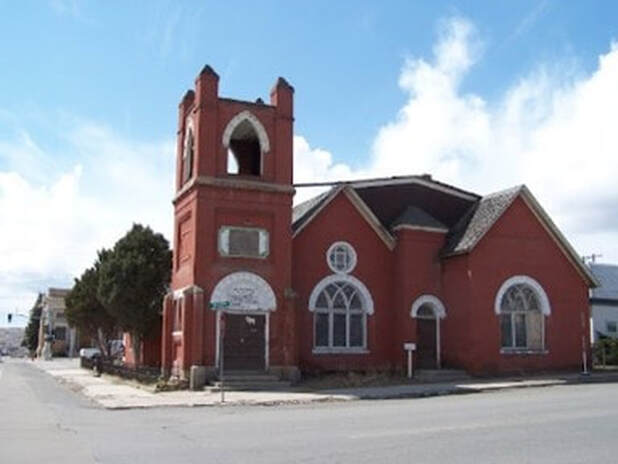
August 1899, Grace became a separate charge, and the church grew rapidly. More room and facilities soon became necessary and in 1902 the building was enlarged and remodeled. At various times over the ensuing years Grace Church shared its pastor with other Butte Methodist churches including, at various times, Silver Bow, Wesley Chapel, Unity, and St. Paul’s.
Reformer Carrie Nation spoke at Grace church during her Butte visit in January 1910. Grace was one of the churches where Mrs. Nation did “a land-office business” selling her books and hatchet pins, although when she was on the streets of Butte and in saloons, her welcome was more ridicule than enthusiasm. After her lecture at the Grace Church, she marched up Arizona Street to the red-light district where she pleaded with working girls to give up their “life of shame,” but she left the A.B.C. Saloon (corner of Wyoming and Mercury) to the orchestra playing “What The Hell Do We Care.”
In 1939 the Silver Bow Park Methodist Church consolidated with Grace and the name was changed to Grace-Silver Bow Methodist Church. In 1941 the parsonage on Arizona Street (north of the church) was remodeled for use as a Sunday School and named Freeman Hall. The home west of the building was purchased for the parsonage. It was the Grace-Silver Bow congregation that assumed the leadership of building of a new church on the “flats” … this is our current Aldersgate congregation.
In 1960, the Grace Methodist Church building was sold to the Church of God and the proceeds were used in the debt retirement of the new Aldersgate Church and its parsonage. The building is now a private residence.
Reformer Carrie Nation spoke at Grace church during her Butte visit in January 1910. Grace was one of the churches where Mrs. Nation did “a land-office business” selling her books and hatchet pins, although when she was on the streets of Butte and in saloons, her welcome was more ridicule than enthusiasm. After her lecture at the Grace Church, she marched up Arizona Street to the red-light district where she pleaded with working girls to give up their “life of shame,” but she left the A.B.C. Saloon (corner of Wyoming and Mercury) to the orchestra playing “What The Hell Do We Care.”
In 1939 the Silver Bow Park Methodist Church consolidated with Grace and the name was changed to Grace-Silver Bow Methodist Church. In 1941 the parsonage on Arizona Street (north of the church) was remodeled for use as a Sunday School and named Freeman Hall. The home west of the building was purchased for the parsonage. It was the Grace-Silver Bow congregation that assumed the leadership of building of a new church on the “flats” … this is our current Aldersgate congregation.
In 1960, the Grace Methodist Church building was sold to the Church of God and the proceeds were used in the debt retirement of the new Aldersgate Church and its parsonage. The building is now a private residence.
On May 7th, as part of 150 years of Methodism in Butte celebration, the public was invited to the location of this historic site. Several former members shared about the two east-side doors, one led to the sanctuary and the other led to Sunday school rooms that also offered overflow to the sanctuary. Grace operated as a center for youth and Sunday school to people in the community and was also a place of weddings during the construction of Aldersgate’s sanctuary. We also learned that on the southern side of the building was the location of the organ, this is evident on the outside of the building.
Pastors who served the Grace congregation …
Ulysses F. Hawk (1888-1889)
T.S. Devitt (1889-1891)
Francis A. Guiler (1891-1893)
Job H. Little (1893-1895)
Thomas H. Hicks (1895-1896)
John Hosking (1896-1899)
A. C. Snow, associate pastor (1897-1900)
James W. Tait (1899-1906)
Frank Edward Dodds (1906-1908)
W. W. Van Dusen (1908-1909)
L. N. Moyer (1909)
William H. Pascoe (1909-1910)
Edward L. Mills (1910-1911)
John A. Meeke (1911-1914)
J. Harry Mitchell (1914-1919)
George M. Carter (1918)
Charles Rhodes (1919-1922)
Charles F. Wolfe (1922-1925)
Edward Smith (1925-1935)
William S. Traweek (1935-1937)
Bert A. Powell (1937-1940)
Howard B. Ricketts (1940-1955)
Clarence E. Means (1955-1956)
Ole Aarvold (1956-1958)
Robert A. Craver (1958)
Ulysses F. Hawk (1888-1889)
T.S. Devitt (1889-1891)
Francis A. Guiler (1891-1893)
Job H. Little (1893-1895)
Thomas H. Hicks (1895-1896)
John Hosking (1896-1899)
A. C. Snow, associate pastor (1897-1900)
James W. Tait (1899-1906)
Frank Edward Dodds (1906-1908)
W. W. Van Dusen (1908-1909)
L. N. Moyer (1909)
William H. Pascoe (1909-1910)
Edward L. Mills (1910-1911)
John A. Meeke (1911-1914)
J. Harry Mitchell (1914-1919)
George M. Carter (1918)
Charles Rhodes (1919-1922)
Charles F. Wolfe (1922-1925)
Edward Smith (1925-1935)
William S. Traweek (1935-1937)
Bert A. Powell (1937-1940)
Howard B. Ricketts (1940-1955)
Clarence E. Means (1955-1956)
Ole Aarvold (1956-1958)
Robert A. Craver (1958)
Mount Bethel Church
In 1883 Mount Bethel Methodist Episcopal Church was started in Walkerville on Clark Street. George C. Stull was appointed the pastor and also served Mountain View. J.W. Bennett then was appointed and worked on the construction of a church building and parsonage. In 1906 the Anaconda Mining Company donated property and the congregation to an existing structure on Main Street. This building, one of the oldest in Butte, was built before 1881 and had served as a general store, a grocery store, and a Catholic Church. During the years of the pastorate of Rev. Frederick T. Spencer (1907-1910), a great revival with over 100 converts who joined the church. In 1922 the basement was converted into a social hall. In 1961, Helen A. Handlin was sent from the church as a missionary nurse to Mexico.
In 1966, the four existing Methodist Churches in Butte laid plans for a larger parish. Three pastors were assigned to the parish: Marion Hixon, Robert Link, and John Pugh. The last Sunday School Christmas Program was held in 1970 with the congregation uniting with Trinity Church in 1970
On April 16th, 2023, as part of 150 years of Methodism in Butte celebration, the public was invited to the location of this historic site. Clark Grant, the latest owner, listened to several members of Mount Bethel describing their recollections. We learned that a caretaker lived in the western end of the building. Other remembrances were of the location of the piano in the sanctuary. It was pointed out that Mount Bethel was the place of worship for all protestants in Walkerville.
Pastors who served the Mount Bethel congregation …
George C. Stull (1883-1884)
J.W. Bennett (1884-1887)
George M. Ryder (1888-1889)
Joel Vigus (1889-1890)
James H. Watters (1890-1891)
Job H. Little (1891-1893)
George W. Jenkins (1893-1894)
Wilder Nutting (1895-1896)
Alexis Berk (1896)
James T. Stephens (1896-1899)
Frederick S. Clemo (1899-1900)
Lee L. Tower (1900-1902)
Charles D. Crouch (1902-1903)
Thomas H. Martin, associate pastor (1902)
Henry A. James (1904-1906)
Samuel A. Oliver (1906-1907)
Frederick T. Spencer (1907-1910)
Thomas H. Barker (1910-1912)
Charles Rhodes (1912-1914)
Harry M. Cooper (1914-1915)
Charles Carlin (1915-1916)
W. H. Berryman (1916)
George J. Stephens (1916-1917)
W. A. Parkinson (1920-1921)
Frederick T. Spencer (1922-1943)
Edward Smith, associate pastor (1925-1926)
Gustavus A. Morrison, associate pastor (1931-1932)
Fred Anstice (1943-1950)
Howard Robertson (1950-1953)
William W. DeBolt (1953-1955)
Ellsworth A. Morgan (1956-1962)
Ronald R. Hallett, associate pastor (1957)
Richard F. Vick (1963-1966)
Butte Methodist Larger Parish (1966-1980)
Marion Hixson (1966-1968), Minister of Preaching
Robert Link (1966-1970), Minister of Education
John E. Pugh (1968-1970)
George C. Stull (1883-1884)
J.W. Bennett (1884-1887)
George M. Ryder (1888-1889)
Joel Vigus (1889-1890)
James H. Watters (1890-1891)
Job H. Little (1891-1893)
George W. Jenkins (1893-1894)
Wilder Nutting (1895-1896)
Alexis Berk (1896)
James T. Stephens (1896-1899)
Frederick S. Clemo (1899-1900)
Lee L. Tower (1900-1902)
Charles D. Crouch (1902-1903)
Thomas H. Martin, associate pastor (1902)
Henry A. James (1904-1906)
Samuel A. Oliver (1906-1907)
Frederick T. Spencer (1907-1910)
Thomas H. Barker (1910-1912)
Charles Rhodes (1912-1914)
Harry M. Cooper (1914-1915)
Charles Carlin (1915-1916)
W. H. Berryman (1916)
George J. Stephens (1916-1917)
W. A. Parkinson (1920-1921)
Frederick T. Spencer (1922-1943)
Edward Smith, associate pastor (1925-1926)
Gustavus A. Morrison, associate pastor (1931-1932)
Fred Anstice (1943-1950)
Howard Robertson (1950-1953)
William W. DeBolt (1953-1955)
Ellsworth A. Morgan (1956-1962)
Ronald R. Hallett, associate pastor (1957)
Richard F. Vick (1963-1966)
Butte Methodist Larger Parish (1966-1980)
Marion Hixson (1966-1968), Minister of Preaching
Robert Link (1966-1970), Minister of Education
John E. Pugh (1968-1970)
Trinity Church
Trinity United Methodist Church was organized as the Centerville Methodist Episcopal Church in 1884 in a rented building on the corner of East Center Street and Wells Street, when Reverend J. W. Bennet gathered a group of 25 young people for Sunday School. They had been meeting for some years in the schoolhouse before Rev. Bennet was appointed. During a lively Christmas program in 1886, the floor collapsed, and members decided it was time to build a church. In 1887, the present site on the corner of LaPlatte and Main Street, was donated by the Butte & Boston Mining Company and construction began with completion by Christmas of 1889. The new building included something quite remarkable for the early 1890's: electric lights, donated by Senator Lee Mantle. In 1896-1897, the original wood-frame building was raised up and a basement built to accommodate the fellowship hall. It was given a brick veneer and a vestibule with choir rooms added. As more time went by, an organ was purchased, a furnace replaced stoves, and memorial windows were dedicated to those who helped to place the Church on the Hill. When Rev. Vigus left in 1891, the church was debt free; had 200 members, 175 listed in the Sunday School and 23 recorded in the choir.
Situated at the border of two working class communities (Centerville and Walkerville), Trinity church was known as one of the "miner's churches," as opposed to the "Mine Owner's church" of Mountain View. Its mission was to the early Cornish miners.
In 1966, the four existing Methodist Churches in Butte laid plans for a larger parish. Three pastors were assigned to the parish: Marion Hixon, Robert Link, and John Pugh. The parish dissolved in 1980 with Bob Craver retaining his appointment with Mountain View and Trinity (also known as the “hill” churches).
In 1966, the four existing Methodist Churches in Butte laid plans for a larger parish. Three pastors were assigned to the parish: Marion Hixon, Robert Link, and John Pugh. The parish dissolved in 1980 with Bob Craver retaining his appointment with Mountain View and Trinity (also known as the “hill” churches).
In 1970, the church united with Mount Bethel to become Trinity United Methodist Church. After a decline in membership and due to the aging of the building, the congregation was closed on July 15, 2015. Several members transferred to Aldersgate. The Sandwich ministry of the current Aldersgate congregation is a remnant of this congregation’s commitment to mission.
On April 16th, 2023, as part of 150 years of Methodism in Butte celebration, the public was invited to the location of this historic site. Rick Chappel, co-owner, opened up the building to some 50 people of the community. Sue DeBree, a former pastor, was on hand to share in her recollections. We learned how the interior stairs were a later addition after the basement was placed underneath the building. We were treated to stories of community dinners and locations of “family” pews.
Pastors who served the Trinity congregation …
J.W. Bennett (1884-1887)
Henry P. Clampitt (1887-1888)
George M. Ryder (1888-1889)
Joel Vigus (1889-1891)
John L. Guiler (1891-1893)
George W. Jenkins (1893-1894)
Wilder Nutting (1895-1897)
John Oxley, associate pastor (1896)
Jacob Mills (1896-1898)
George Feese (1898-1899)
John Hosking (1899-1903)
Samuel J. Hocking (1903-1907)
John Hosking (1907-1908)
Samuel A. Oliver (1908-1912)
William E. Snider (1910-1912)
Paul M. Adams (1912-1914)
John G. Ross (1914-1917)
Henry A. James (1917-1919)
William H. Pascoe (1919-1922)
Frederick T. Spencer (1922-1943)
Edward Smith, associate pastor (1925-1926)
Gustavus A. Morrison, associate pastor (1931-1932)
Fred Anstice (1943-1950)
Howard Robertson (1950-1953)
William W. DeBolt (1953-1955)
Ellsworth A. Morgan (1956-1962)
Ronald R. Hallett, associate pastor (1957)
Richard F. Vick (1963-1966)
Butte Methodist Larger Parish (1966-1980)
Marion Hixson (1966-1968), Minister of Preaching
Robert Link (1966-1970), Minister of Education
John E. Pugh (1968-1972)
Gayle Sandholm (1970-1972)
Donald Keefauver (1971-1972)
Roger Robinson (1972-1974)
Daniel W. Wanders (1972-1976)
Robert C. Baker (1975-1977)
John W. Bartram (1976-1979)
Robert A. Craver (1979-1980)
Robert A. Craver (1981-1992)
Susan K. DeBree (1993-2002)
Richard Rice (2002-2005)
Ben Nardi (2005-2006)
Mike Parr (2006-2007)
Gary Treglown (2007-2009)
Dee Anna (2009-2012)
Ron Martin Dent (2012-2015)
J.W. Bennett (1884-1887)
Henry P. Clampitt (1887-1888)
George M. Ryder (1888-1889)
Joel Vigus (1889-1891)
John L. Guiler (1891-1893)
George W. Jenkins (1893-1894)
Wilder Nutting (1895-1897)
John Oxley, associate pastor (1896)
Jacob Mills (1896-1898)
George Feese (1898-1899)
John Hosking (1899-1903)
Samuel J. Hocking (1903-1907)
John Hosking (1907-1908)
Samuel A. Oliver (1908-1912)
William E. Snider (1910-1912)
Paul M. Adams (1912-1914)
John G. Ross (1914-1917)
Henry A. James (1917-1919)
William H. Pascoe (1919-1922)
Frederick T. Spencer (1922-1943)
Edward Smith, associate pastor (1925-1926)
Gustavus A. Morrison, associate pastor (1931-1932)
Fred Anstice (1943-1950)
Howard Robertson (1950-1953)
William W. DeBolt (1953-1955)
Ellsworth A. Morgan (1956-1962)
Ronald R. Hallett, associate pastor (1957)
Richard F. Vick (1963-1966)
Butte Methodist Larger Parish (1966-1980)
Marion Hixson (1966-1968), Minister of Preaching
Robert Link (1966-1970), Minister of Education
John E. Pugh (1968-1972)
Gayle Sandholm (1970-1972)
Donald Keefauver (1971-1972)
Roger Robinson (1972-1974)
Daniel W. Wanders (1972-1976)
Robert C. Baker (1975-1977)
John W. Bartram (1976-1979)
Robert A. Craver (1979-1980)
Robert A. Craver (1981-1992)
Susan K. DeBree (1993-2002)
Richard Rice (2002-2005)
Ben Nardi (2005-2006)
Mike Parr (2006-2007)
Gary Treglown (2007-2009)
Dee Anna (2009-2012)
Ron Martin Dent (2012-2015)
Unity Church
Unity Methodist Episcopal Church was begun in 1887 by a half-dozen people meeting in a room over a saloon in Meaderville. In 1889, the church was built on Meaderville’s Main Street and was enlarged in 1896. The mining industry encroached on the church building and in 1906 construction was begun on lots donated by the Boston and Montana Mining Company. This location was still on Main Street but east of Silver Bow Creek, between the communities of Meaderville and McQueen and across from the Franklin School. The cornerstone was laid on August 19, 1907, by the Montana Grand Lodge of A.F and A.M. and the Montana State Band played with the Men’s Glee Club singing. The church succumbed to the industrial advances of the mining industry. The Anaconda mining company purchased the entire neighborhoods of Meaderville and McQueen and subsequently set for the destruction of the building (the current Berkley Pit would be the location of these neighborhoods). On March 15, 1964, the final service of Unity Methodist Church was held. The organ and the pews were taken to the Lake County Community Church in Ronan and the proceeds from the sale of the church ($15,000) were used for the building of the Aldersgate parsonage on Kossuth Street.
On May 7th, as part of 150 years of Methodism in Butte celebration, the public was invited to the location of this historic site. We met in the viewing stand of the Berkeley Pit as our location is underwater.
We learned from Donna Shovlin, long-time member of the church, that the building was created with three rooms in the basement for the pastor. Unity was always shared with another Methodist church, so the pastor never lived in the basement. The rooms became locations for Sunday school space and where Santa was hidden during the Christmas program. Donna reported that one lucky child was always chosen to go “find” Santa. The congregation was home for people in the East Butte, Meaderville, and McQueen neighborhoods. The men from this congregation personally helped with the building of Aldersgate.
We learned from Donna Shovlin, long-time member of the church, that the building was created with three rooms in the basement for the pastor. Unity was always shared with another Methodist church, so the pastor never lived in the basement. The rooms became locations for Sunday school space and where Santa was hidden during the Christmas program. Donna reported that one lucky child was always chosen to go “find” Santa. The congregation was home for people in the East Butte, Meaderville, and McQueen neighborhoods. The men from this congregation personally helped with the building of Aldersgate.
Pastors who served the Unity congregation …
J. W. Bennett (1887)
Ulysses F. Hawk (1888-1890)
T.S. Devitt (1891)
John J. Bennett (1892-1893)
Job H. Little (1893-1895)
Thomas H. Hicks (1895-1896)
John Hosking (1896-1899)
A. C. Snow, associate pastor (1897-1900)
R.H. Shafer (1900)
Lee L. Tower (1900-1902)
Charles D. Crouch (1902-1903)
John Chrigwin (1904)
Henry A. James (1904-1906)
Samuel A. Oliver (1906-1908)
Thomas H. Martin (1909-1910)
James E. Coad (1910-1912)
John J. Bennett (1912)
R.T. Westren (1912-1913)
Clifton N. Hurst (1913-1917)
William H. Pascoe, associate pastor (1914)
J.B. Cary, associate pastor (1914)
W.T. Harris, associate pastor (1916)
Fred C. Fulford (1917-1921)
Hubert W. Woods (1921-1923)
Charles Rhodes (1923-1926)
Ernest J. Mills (1926-1931)
Lawrence E Swanson, associate pastor (1929-1930)
Gustavus A. Morrison, associate pastor (1930-1931)
Eustace Anderson (1933-1935)
William J. Vigus (1934-1936)
Bert A. Powell (1937-1940)
Howard B. Ricketts (1940-1955)
Clarence E. Means (1955-1956)
Ole Aarvold (1956-1958)
J. W. Bennett (1887)
Ulysses F. Hawk (1888-1890)
T.S. Devitt (1891)
John J. Bennett (1892-1893)
Job H. Little (1893-1895)
Thomas H. Hicks (1895-1896)
John Hosking (1896-1899)
A. C. Snow, associate pastor (1897-1900)
R.H. Shafer (1900)
Lee L. Tower (1900-1902)
Charles D. Crouch (1902-1903)
John Chrigwin (1904)
Henry A. James (1904-1906)
Samuel A. Oliver (1906-1908)
Thomas H. Martin (1909-1910)
James E. Coad (1910-1912)
John J. Bennett (1912)
R.T. Westren (1912-1913)
Clifton N. Hurst (1913-1917)
William H. Pascoe, associate pastor (1914)
J.B. Cary, associate pastor (1914)
W.T. Harris, associate pastor (1916)
Fred C. Fulford (1917-1921)
Hubert W. Woods (1921-1923)
Charles Rhodes (1923-1926)
Ernest J. Mills (1926-1931)
Lawrence E Swanson, associate pastor (1929-1930)
Gustavus A. Morrison, associate pastor (1930-1931)
Eustace Anderson (1933-1935)
William J. Vigus (1934-1936)
Bert A. Powell (1937-1940)
Howard B. Ricketts (1940-1955)
Clarence E. Means (1955-1956)
Ole Aarvold (1956-1958)
Saint George / Silver Bow Chapel
The congregation was known as Saint George Methodist Episcopal Church went it was started in 1890. The Order of St. George was a fraternal organization amongst the Cornish immigrants to the area and influenced the naming of the church. The building was located on the northeast corner of Silver Bow Boulevard and Adams Street. In 1919, three lots were purchased on Grand Avenue and in 1921, the one-room building was moved to the corner of Grand and Thornton with it facing Thornton Avenue. It was often called the “little White Church”. The name was officially changed to Silver Bow Chapel and a kitchen was added to the building. The congregation served the “flats” area of Butte and grew to the point where the Sunday School gradually outgrew the building. The church maintained an active Epworth League, a junior choir of boys and girls who sang on the radio, and a very active ladies group, known as the Friendship Circle.
In 1939 the congregation merged with Grace Church and the united congregation was known as Grace Silver Bow Methodist Church. The Sunday school unit continued to meet at various locations (Grace, Unity, and Saint Paul) until the Social Hall of the Aldersgate church was completed in 1958.
In 1939 the congregation merged with Grace Church and the united congregation was known as Grace Silver Bow Methodist Church. The Sunday school unit continued to meet at various locations (Grace, Unity, and Saint Paul) until the Social Hall of the Aldersgate church was completed in 1958.
The former building was sold to the Bible Baptist Church and moved to Hannibal Street, where it was remodeled. The building is now used by Heritage Bible Church.
On April 23rd, 2023, as part of 150 years of Methodism in Butte celebration, the public was invited to the location of this historic site. The current location of Heritage Bible Church is under remodel. Several members of the public shared their recollection of attending youth group when the church was located on Grand Avenue.
Pastors who served the Saint George / Silver Bow congregation …
Frank E. Brush (1890-1892)
Wilder Nutting (1895-1897)
John Oxley, associate pastor (1896)
A. C. Snow (1897-1900)
John Chrigwin (1904)
Frederick T. Spencer (1907-1909)
Thomas H. Martin (1909-1910)
James E. Coad (1910-1912)
R.T. Westren (1912-1913)
Clifton N. Hurst (1913-1914)
Harry M. Cooper (1914-1915)
Joseph M. Papa (1915-1916)
Lee Hayes (1916)
J.B. Penhall (1917)
Fred C. Fulford (1917-1921)
Hubert W. Woods (1922-1923)
Charles Rhodes (1923-1926)
Ernest J. Mills (1926-1931)
Lawrence E Swanson (1929-1930)
Gustavus A. Morrison (1930-1932)
Eustace Anderson (1933-1935)
William S. Traweek (1935-1937)
Bert A. Powell (1937-1940)
Howard B. Ricketts (1940-1955)
Clarence E. Means (1955-1956)
Ole Aarvold (1956-1958)
Frank E. Brush (1890-1892)
Wilder Nutting (1895-1897)
John Oxley, associate pastor (1896)
A. C. Snow (1897-1900)
John Chrigwin (1904)
Frederick T. Spencer (1907-1909)
Thomas H. Martin (1909-1910)
James E. Coad (1910-1912)
R.T. Westren (1912-1913)
Clifton N. Hurst (1913-1914)
Harry M. Cooper (1914-1915)
Joseph M. Papa (1915-1916)
Lee Hayes (1916)
J.B. Penhall (1917)
Fred C. Fulford (1917-1921)
Hubert W. Woods (1922-1923)
Charles Rhodes (1923-1926)
Ernest J. Mills (1926-1931)
Lawrence E Swanson (1929-1930)
Gustavus A. Morrison (1930-1932)
Eustace Anderson (1933-1935)
William S. Traweek (1935-1937)
Bert A. Powell (1937-1940)
Howard B. Ricketts (1940-1955)
Clarence E. Means (1955-1956)
Ole Aarvold (1956-1958)
Scandinavian Church
The church was still a functioning congregation until the late 1920’s. In the 1932 Journal of the Western Norwegian Danish Conference, it was reported that the Butte congregation was closed due to “meager support.”
The northwest corner (101 W. Copper) held the Scandinavian Methodist Episcopal Church, built between 1891 and 1900. You can see its 45-foot tower at left center in the photo here. (Along the left edge is the O’Rourke apartments; at center, to right and in front of the church is the Bail Bonds/Union building; the mine complex in the distance is the Original.) The church was actually on the second floor, with housekeeping rooms on the first level. Butte architect Pete Godtland says his mother worked there. The building was still standing in 1957, but the upper floor was vacated before 1951 and the building was being used as a two-flat apartment on the first floor only.
The northwest corner (101 W. Copper) held the Scandinavian Methodist Episcopal Church, built between 1891 and 1900. You can see its 45-foot tower at left center in the photo here. (Along the left edge is the O’Rourke apartments; at center, to right and in front of the church is the Bail Bonds/Union building; the mine complex in the distance is the Original.) The church was actually on the second floor, with housekeeping rooms on the first level. Butte architect Pete Godtland says his mother worked there. The building was still standing in 1957, but the upper floor was vacated before 1951 and the building was being used as a two-flat apartment on the first floor only.
As early as 1892 a pastor was appointed by the Montana Conference to the Butte Scandinavian Church. It was later known as the Norwegian Danish Church.
On April 23rd, 2023, as part of 150 years of Methodism in Butte celebration, the public was invited to the location of this historic site. Very little is known of this congregation. We do know that the neighborhood (just south of the historic Original Mine) was home to an active Scandinavian community. Across the street to the east sat the former location of Gold Hill Lutheran Church. Our records were updated as we gained access to a picture of the building that was taken in 1976. The location is now a vacant lot.
Pastors who served the Scandinavian congregation …
Carl Erickson (1892-1893)
G. S. Fjeld (1899)
O. A. Doblough (1908)
Carl Erickson (1892-1893)
G. S. Fjeld (1899)
O. A. Doblough (1908)
Wesley Chapel
Wesley Chapel began in 1897 as a mission Sabbath School in the Parrot Flats neighborhood. It was known as the East Side Mission until 1900 when the name was changed to Wesley Chapel. In 1911 a facility was built at 1000 Talbot Avenue (later Mercury Street) and it shared a pastor with several other Methodist churches and then was served mainly by local church lay preachers. In 1941 the Pentecostal Church rented the building and later purchased it. The building was destroyed by the Anaconda Company with the expansion of the Berkeley Pit.
On May 7th, as part of 150 years of Methodism in Butte celebration, the public was invited to the location of this historic site. We met in the viewing stand of the Berkeley Pit as our location is underwater.
On May 7th, as part of 150 years of Methodism in Butte celebration, the public was invited to the location of this historic site. We met in the viewing stand of the Berkeley Pit as our location is underwater.
Pastors who served the Wesley Chapel congregation …
W.C. Shippen (1897)
Samuel A. Oliver (1907-1908)
Frederick T. Spencer (1909-1910)
Thomas H. Barker (1910-1912)
Charles Rhodes (1912-1914)
Charles R. Carlin (1915-1916)
George J. Stephens (1916-1917)
Thomas R. Clarkson (1917-1919)
George Reid (1919-1920)
W. A. Parkinson (1920)
John A. Smith (1920-1921)
Charles F. Wolfe (1922-1925)
T. H. Rhodda (1925-1941)
W.C. Shippen (1897)
Samuel A. Oliver (1907-1908)
Frederick T. Spencer (1909-1910)
Thomas H. Barker (1910-1912)
Charles Rhodes (1912-1914)
Charles R. Carlin (1915-1916)
George J. Stephens (1916-1917)
Thomas R. Clarkson (1917-1919)
George Reid (1919-1920)
W. A. Parkinson (1920)
John A. Smith (1920-1921)
Charles F. Wolfe (1922-1925)
T. H. Rhodda (1925-1941)
Bellevue / Lowell Avenue Church
The first mention of the Lowell Avenue Methodist Episcopal Church, South is in 1907 when the Rev. Howard Davis served a location called “4th Avenue South Side”. There is information in the record that a Methodist Episcopal Church, South operated on Whitman Avenue. We believe this is the start of the Bellevue and then Lowell Avenue congregation.
In 1920 the congregation moved to 1701 Lowell Avenue where the name became Bellevue. The first mention of a name change to Lowell Avenue is in 1924.
In 1954, the building was “modernized”’ and renamed St. Paul’s Methodist Church. As the congregation was never large and the opportunity to join in with several other Methodist congregations, it was decided in 1959 to merge with Grace, Unity, Silver Bow, and Wesley Chapel and form Aldersgate Methodist Church. The building sat vacant for several years and in 1965 was sold to the Pentecostal Church and is now known as “The Rock”.
In 1920 the congregation moved to 1701 Lowell Avenue where the name became Bellevue. The first mention of a name change to Lowell Avenue is in 1924.
In 1954, the building was “modernized”’ and renamed St. Paul’s Methodist Church. As the congregation was never large and the opportunity to join in with several other Methodist congregations, it was decided in 1959 to merge with Grace, Unity, Silver Bow, and Wesley Chapel and form Aldersgate Methodist Church. The building sat vacant for several years and in 1965 was sold to the Pentecostal Church and is now known as “The Rock”.
On April 30th, as part of 150 years of Methodism in Butte celebration, the public was invited to the location of this historic site. JC McPherson, current pastor of the Church on the Rock invited us in to listen to the stories. We heard about the balcony and how it was always the place for music. We learned that this location was built for the new neighborhood on “the Flats” of Butte. We also gained a sense of why the name changed to Saint Paul’s. When the other Saint Paul’s Methodist Episcopal Church, South closed, members transferred to what was then referred to as Lowell Avenue. When the church was remodeled the older members who were part of the original Saint Paul’s suggested that their name be changed to Saint Paul’s because it sounded more “church-like.”
Pastors who served the Bellevue / Lowell Avenue congregation …
H. Howard Davis (1907-1909)
Phillip Hartman (1908-1910)
Roy E. Early (1915)
Seth R. Steele (1915-1917)
Charles A. Rexroad (1917-1918)
Coy R. Sims (1918)
Edward J. Harper (1918-1919)
Clarence J. Atkins (1920)
J.P. Penhall (1922)
J. C. Martin (1924-1926)
Thomas B. Reagan (1929-1933)
Earl J. Bracken (1941-1942)
Fred Anstice (1943-1950)
Robert A. Craver (1957-1959)
H. Howard Davis (1907-1909)
Phillip Hartman (1908-1910)
Roy E. Early (1915)
Seth R. Steele (1915-1917)
Charles A. Rexroad (1917-1918)
Coy R. Sims (1918)
Edward J. Harper (1918-1919)
Clarence J. Atkins (1920)
J.P. Penhall (1922)
J. C. Martin (1924-1926)
Thomas B. Reagan (1929-1933)
Earl J. Bracken (1941-1942)
Fred Anstice (1943-1950)
Robert A. Craver (1957-1959)
Italian Mission
In 1911 an Italian Methodist Mission was established near Silver Bow Creek in Meaderville (on land donated by the Anaconda Company). It sometimes is referred to as the Epworth Italian Mission. The construction of the St. Helena’s Roman Catholic Church drew the Italian population of Meaderville and McQueen away from the Mission and it was deemed by the Montana conference to close. The land and building was donated back to the Anaconda Company which in turn gave it to the Butte Mines Band.
On May 7th, as part of 150 years of Methodism in Butte celebration, the public was invited to the location of this historic site. We met in the viewing stand of the Berkeley Pit as our location is underwater.
On May 7th, as part of 150 years of Methodism in Butte celebration, the public was invited to the location of this historic site. We met in the viewing stand of the Berkeley Pit as our location is underwater.
Pastors who served the Italian Mission …
Dominco Dispace (1911-1912)
Amadeo Trappolini (1917-1918)
Hubert W. Woods (1921)
Dominco Dispace (1911-1912)
Amadeo Trappolini (1917-1918)
Hubert W. Woods (1921)
Shaffer Chapel African Methodist Episcopal Church
The African Methodist Episcopal Church (AME) grew out of the Free African Society (FAS) which Richard Allen, Absalom Jones, and others established in Philadelphia in 1787. When officials at St. George’s Methodist Episcopal Church pulled blacks off their knees while praying, members of the FAS decided to transform transform their mutual aid society into an African congregation. In 1794 Bethel AME was dedicated with Allen as pastor, and eventual Bishop.
During the 1890s, the A.M.E. Church became a presence in several growing Montana cities, and congregations were established in Helena, Great Falls, Missoula, Anaconda, and Butte. In 1894, the Colorado Conference of the A.M.E. Church came to Montana, bolstering the efforts of all these congregations. That same year, black communities were courted by both Marcus Daly and William Clark in the competition to designate the state’s capital, with a rail excursion to Anaconda and baseball games in Helena. Clark launched The Colored Citizen, newspaper in Helena that lobbied unabashedly for Helena as state political headquarters. In fact, Rev. Charles Cushingberry of the Butte A.M.E. Church got caught up in the contest, coming out strongly against Helena in such a way that it was alleged he was seeking payment for his support, and he was forced to resign his post.
In 1892, the first building was located at the corner of Idaho and Mercury (google maps – current fire station). In 1901, Shaffer Chapel vacated the building to Bethel Baptist, the only other black congregation in town.
During the 1890s, the A.M.E. Church became a presence in several growing Montana cities, and congregations were established in Helena, Great Falls, Missoula, Anaconda, and Butte. In 1894, the Colorado Conference of the A.M.E. Church came to Montana, bolstering the efforts of all these congregations. That same year, black communities were courted by both Marcus Daly and William Clark in the competition to designate the state’s capital, with a rail excursion to Anaconda and baseball games in Helena. Clark launched The Colored Citizen, newspaper in Helena that lobbied unabashedly for Helena as state political headquarters. In fact, Rev. Charles Cushingberry of the Butte A.M.E. Church got caught up in the contest, coming out strongly against Helena in such a way that it was alleged he was seeking payment for his support, and he was forced to resign his post.
In 1892, the first building was located at the corner of Idaho and Mercury (google maps – current fire station). In 1901, Shaffer Chapel vacated the building to Bethel Baptist, the only other black congregation in town.
The new building (and one currently standing) was constructed as a gift from Copper King, W.A. Clark, as a gift to the block population of Butte. He also donated the carpet and chairs. The church was known as Shaffer Chapel, named after Cornelius T. Shaffer, who was elected Bishop in 1900. He arrived in 1902 to dedicate the building. To help retire the debt, Edith Roosevelt, President Theodore Roosevelt’s wife, donated a globe to be auctioned off.
On March 6, 1913, Booker T. Washington, visited Butte and delivered a speech at the Auditorium in the old Butte Public Library on West Broadway Street to “a large audience about equally divided between the white and black races,” according to the Butte Miner. The presentation was followed by a banquet in Washington’s honor at Shaffer Chapel AME Church.
The congregation ceased to exist in 1964 as the number of African-Americans dwindled starting after World War II.
The building at 602 South Idaho is listed in the National Register as a contributing building within the Butte-Anaconda National Historic Landmark district. It gains further significance for its association with the history of the African American community in Butte and Montana, as well as its association with the African Methodist Episcopal Church. The building historically known as Shaffer’s Chapel is the only remaining church building in Butte that once hosted an all-black congregation, and was one of the only public centers of the African American community during the twentieth century. In addition, Shaffer’s Chapel is one of only 31 extant buildings out of 103 original structures identified as having significance to the history of African Americans in Butte.
On March 6, 1913, Booker T. Washington, visited Butte and delivered a speech at the Auditorium in the old Butte Public Library on West Broadway Street to “a large audience about equally divided between the white and black races,” according to the Butte Miner. The presentation was followed by a banquet in Washington’s honor at Shaffer Chapel AME Church.
The congregation ceased to exist in 1964 as the number of African-Americans dwindled starting after World War II.
The building at 602 South Idaho is listed in the National Register as a contributing building within the Butte-Anaconda National Historic Landmark district. It gains further significance for its association with the history of the African American community in Butte and Montana, as well as its association with the African Methodist Episcopal Church. The building historically known as Shaffer’s Chapel is the only remaining church building in Butte that once hosted an all-black congregation, and was one of the only public centers of the African American community during the twentieth century. In addition, Shaffer’s Chapel is one of only 31 extant buildings out of 103 original structures identified as having significance to the history of African Americans in Butte.
On May 7th, as part of 150 years of Methodism in Butte celebration, the public was invited to the location of this historic site. This congregation did not feed into the existing Aldersgate church. We honored its history as a significant witness to the African-American population of Butte. Those who gathered noted the significant history of this congregation, yet no plaque to honor it, yet it is listed on the National Register of Historic Places. Aldersgate is dedicated to purchasing and placing the plaque for all to see.
Pastors who served the Shaffer Chapel AME congregation …
Charles Cushingberry (1894)
Jordan Allen (1901-1904)
Benjamin McIntyre (1904-1906)
Charles Cushingberry (1894)
Jordan Allen (1901-1904)
Benjamin McIntyre (1904-1906)
Aldersgate United Methodist Church
In 1925, the subject of establishing a more centralized Methodist congregation was first addressed. It was to be known as the Butte City Parish of the Methodist Episcopal Churches. The Depression of the 30s and the start of the World War in the 40’s shelved he plan until a later decade.
in 1952, five churches (Grace, Unity, Silver Bow, St. Paul's, and Wesley Chapel) again recognized the need to plan for a new church to serve the growing areas to the south of Butte and this time incorporated the Methodist Church Extension Association of Silver Bow County. In 1954, additional property at Grand and Thornton Avenues was purchased (along with land already owned by the Silver Bow congregation) as a site of the new church with a formal merger of Unity, Saint Paul’s, and Grace took place on April 27, 1958
in 1952, five churches (Grace, Unity, Silver Bow, St. Paul's, and Wesley Chapel) again recognized the need to plan for a new church to serve the growing areas to the south of Butte and this time incorporated the Methodist Church Extension Association of Silver Bow County. In 1954, additional property at Grand and Thornton Avenues was purchased (along with land already owned by the Silver Bow congregation) as a site of the new church with a formal merger of Unity, Saint Paul’s, and Grace took place on April 27, 1958
The Fellowship Hall of the new Aldersgate Methodist Church began with a groundbreaking ceremony on April 27, 1958. Worship services were held in this “gymnasium” as construction continued on the sanctuary, which was begun on June 16, 1963, with the first services held on February 9, 1964, in the completed building. Consecration (referring to a debt-free building) took place several weeks later on February 23, 1964.
In September of 1965 the four remaining Methodist churches of Butte (Mountain View, Trinity, Mt. Bethel, and Aldersgate) started the discussions for a combined parish. These plans were finalized on April 17, 1966 with work to begin on September 1, 1966. A team of three pastors were assigned to serve the Butte Methodist Larger Parish. In 1967, one of the pastors, John Pugh, was instrumental in starting regular Radio broadcasts of the Mountain View worship services on KBOW 550 AM. At that time Mountain View was chosen to host the radio broadcasts because it not only had the magnificent Kilgan pipe organ, but it also had the largest choir of any of the other churches. In 1970, Mt. Bethel merged with Trinity and two pastors were appointed to the Parish. Worship Services were held at three congregations, with church schools organized at Mountain View and Aldersgate. Youth groups, women’s groups, prayers groups, and study groups functioned mainly at Aldersgate. The Butte Methodist Larger Parish existed for 15 years, but due to the decline of population of Butte and the difficulty of maintaining the original vision of the Parish it was dissolved on December 31, 1980.
Lyle Hamilton was appointed as the first “solo” pastor (after the dissolution of the Parish) and to this date is the longest serving pastor of Aldersgate. Jerry Bechtel was appointed in 1993 to replace Jim Stewart who left the ministry. Growth in attendance and commitment to financial stewardship increased dramatically. Communion every Sunday became a mainstay for worship and many individuals attended the Walk to Emmaus program through Jerry’s leadership. Esther Angel, was hired as an associate in Jerry’s final year, which turned out to be a blessing. Jerry became ill and Esther continued on as the pastor for the charge. Unfortunately, Esther became ill and she was replaced by Jim Heikes. This was a time of economic decline for the community, and this was mirrored in the congregation.
Dave Andersen served until his retirement in 2017. This was a time of financial stability and increased participation of the church in the community. He was replaced Melissa Engel, in her first full-time appointment. Melissa became the first pastor to live in a parsonage in some time. She left the ministry in June 2019, and the church was left without an appointed pastor for 6 months. 14 members of the congregation led worship and kept the ministry of Aldersgate vital. Significant improvements to the church building and the parsonage took place during this period. Sue McNicol from Helena served as an interim pastor until Matthias Krier was appointed full-time. Matthias’ tenure was marred by the COVID-19 pandemic, and he retired after two years. In 2022, Seth Leypoldt, from Nebraska was appointed to Aldersgate. Seth added an emphasis of children and youth to his ministry and work began on establishing a secure financial footing for the congregation. Upon his arrival, work soon began for the big celebration of 150 OF METHODISM IN BUTTE to be celebrated on May 21, 2023.
Dave Andersen served until his retirement in 2017. This was a time of financial stability and increased participation of the church in the community. He was replaced Melissa Engel, in her first full-time appointment. Melissa became the first pastor to live in a parsonage in some time. She left the ministry in June 2019, and the church was left without an appointed pastor for 6 months. 14 members of the congregation led worship and kept the ministry of Aldersgate vital. Significant improvements to the church building and the parsonage took place during this period. Sue McNicol from Helena served as an interim pastor until Matthias Krier was appointed full-time. Matthias’ tenure was marred by the COVID-19 pandemic, and he retired after two years. In 2022, Seth Leypoldt, from Nebraska was appointed to Aldersgate. Seth added an emphasis of children and youth to his ministry and work began on establishing a secure financial footing for the congregation. Upon his arrival, work soon began for the big celebration of 150 OF METHODISM IN BUTTE to be celebrated on May 21, 2023.
Pastors who served the Aldersgate congregation …
Ole A. Aarvold (1959-1964)
Robert A. Craver, associate pastor (1959)
John L. Davis (1964-1966)
Butte Methodist Larger Parish (1966-1980)
Marion Hixson (1966-1968), Minister of Preaching
Robert Link (1966-1970), Minister of Education
John E. Pugh (1968-1972)
Gayle Sandholm (1970-1972)
Donald Keefauver (1971-1972)
Roger Robinson (1972-1974)
Daniel W. Wanders (1972-1976)
Robert C. Baker (1975-1977)
John W. Bartram (1976-1979)
Robert A. Craver (1979-1980)
Lyle W. Hamilton (1979-1988)
S. James Stewart (1988-1993)
Jerome “Jerry” K. Bechtle (1993-1999)
Esther Angel (1998-2005)
Jim Heikes (2005-2012)
Dave Andersen (2012-2017)
Melissa Engel (2017-2019)
Sue McNicol (2019-2020)
Matthias Krier (2020-2022)
Seth L. Leypoldt (2022- )
Ole A. Aarvold (1959-1964)
Robert A. Craver, associate pastor (1959)
John L. Davis (1964-1966)
Butte Methodist Larger Parish (1966-1980)
Marion Hixson (1966-1968), Minister of Preaching
Robert Link (1966-1970), Minister of Education
John E. Pugh (1968-1972)
Gayle Sandholm (1970-1972)
Donald Keefauver (1971-1972)
Roger Robinson (1972-1974)
Daniel W. Wanders (1972-1976)
Robert C. Baker (1975-1977)
John W. Bartram (1976-1979)
Robert A. Craver (1979-1980)
Lyle W. Hamilton (1979-1988)
S. James Stewart (1988-1993)
Jerome “Jerry” K. Bechtle (1993-1999)
Esther Angel (1998-2005)
Jim Heikes (2005-2012)
Dave Andersen (2012-2017)
Melissa Engel (2017-2019)
Sue McNicol (2019-2020)
Matthias Krier (2020-2022)
Seth L. Leypoldt (2022- )
The Butte Deaconess Hospital
The home deaconess institution was established in Chicago by the Methodist Episcopal Church to advance the health and well-being of the community with a compassionate and spirit. The work in Montana was started in 1903 in Great Falls. Other Deaconess Hospitals were built in Glasgow and Bozeman. These institutions were all built by popular subscription of people interested in the welfare of the community and work of the health care personnel. The Butte hospital campaign proposed to show the world that Butte citizens would come together to build an institution that is “not to preach but to practice.”
On May 21, 1917, the hospital campaign started and was supported by physicians, working people, and representatives of every line of activity in Butte. By 1918 the funding had been secured and the Methodist Church completed the building at the cost of $100,000 on Stuart Avenue. Miss Ida Hills, a graduate of the Great Falls Deaconess Hospitals’ Nursing Program became the first superintendent. From 1922-1924, the hospital was run by Dr. Phebe Ferris, a Butte native and member of Mountain View Methodist Episcopal Church. She had recently returned from her missionary work in India and China. In 1928, the hospital closed due to financial reasons.
On May 21, 1917, the hospital campaign started and was supported by physicians, working people, and representatives of every line of activity in Butte. By 1918 the funding had been secured and the Methodist Church completed the building at the cost of $100,000 on Stuart Avenue. Miss Ida Hills, a graduate of the Great Falls Deaconess Hospitals’ Nursing Program became the first superintendent. From 1922-1924, the hospital was run by Dr. Phebe Ferris, a Butte native and member of Mountain View Methodist Episcopal Church. She had recently returned from her missionary work in India and China. In 1928, the hospital closed due to financial reasons.
The building was later used by the Seventh Day Adventist Church as a nursing home, called the Summit Valley Sanitarium. In 2022, it was for sale (google maps link) after being a private residence.
Mountain View Social Development Center
Since 1981, the Mountain View Social Development Center has operated as a place where adult persons with developmental disabilities find friends, find help with need, and find opportunities for recreational and learning experiences. It was founded by Rev. Bob and Donna Craver during their ministry at Mountain View. They had a developmentally disabled child and were deeply concerned about providing quality living and learning experiences for other disabled adults. The Center has been located at different places over the years.
The Center began in the home of the Craver’s and started with four clients. It was soon moved to the Mountain View United Methodist Church and was funded by the Yellowstone Conference. As the program grew, the Center moved to the newly vacated Blaine School in Walkerville (google maps link). Donna Craver served as the Executive Director for 14 years. Lisa Kopp succeeded her in 1994.
The Center began in the home of the Craver’s and started with four clients. It was soon moved to the Mountain View United Methodist Church and was funded by the Yellowstone Conference. As the program grew, the Center moved to the newly vacated Blaine School in Walkerville (google maps link). Donna Craver served as the Executive Director for 14 years. Lisa Kopp succeeded her in 1994.
In 1996, the program moved to its current location in the education wing of St. Ann’s Catholic Church. Funding comes from clients who qualify for state assistance.
Mountain View Social Development Center provides day program services to individuals with developmental disabilities who are over 55 years of age.
